Lost crypto to a typo? Spent days chasing invoices? Request Network uses blockchain to get rid of errors, automate accounting, and turn payments into seamless transactions.
Keep reading
Have you ever sent an invoice and then spent the next week chasing your payment? Or worse… have you ever lost crypto by sending it to the wrong address!? If you have, well, you’re not the only one. And that’s exactly what Request has come to fix.
Traditional systems for the most part still rely on an awkward mix of middlemen, manual data entry, and accounting software that belongs in a different era. On top of all that, human error will always be a factor. Request (REQ) aims to cut through these inefficiencies by offering a blockchain solution for creating, tracking, and settling payments.
Whether you're just dipping your toes into crypto or you're already swimming in the deep end of Web3 finance, Request stands out for more than one reason. So, let’s dive in and find out!
How Request Actually Works (Without Jargon)
At its core, Request Network allows someone to issue a secure, immutable payment request through blockchain technology. Think of it this way: instead of manually sending funds to a wallet address (which carries the very real risk of one mistyped character sending your money into the digital void), the payee generates an invoice through a smart contract. The payer then approves it with a single transaction. Simple, clean, and significantly less prone to expensive mistakes.
This model reduces common payment errors, improves recordkeeping for everyone involved, and creates what financial people love to call "a single source of truth." Because all payment data lives on-chain, financial histories become independently verifiable without needing to trust third-party payment processors or wade through conflicting records.
It goes without saying, your accountant’s job gets significantly simpler. Payment requests, transaction amounts, due dates, tax information, and complete audit trails can all exist within the same blockchain-based system.
Why Businesses Are Building on Request
Request has become something of an unsung hero in the Web3 infrastructure world. Many blockchain organizations (from DeFi protocols to gaming studios) have adopted it because it addresses challenges that traditional payment systems simply weren't designed to handle.
Here’s what makes it special:
- Reliable audit trails. Every single request is timestamped, immutable, and independently verifiable, an accountant's dream, really.
- Built-in compliance capabilities. Request's architecture naturally supports detailed tax reporting and regulatory workflows, which matters considerably more than it sounds.
- Easy integration options. Businesses can connect Request to existing platforms like WooCommerce through tools such as WooReq, or leverage Request Finance for more sophisticated requirements.
- True scalability. The network handles recurring payments, batch transactions, and multi-chain activity across more than 25 different blockchains without breaking a sweat.
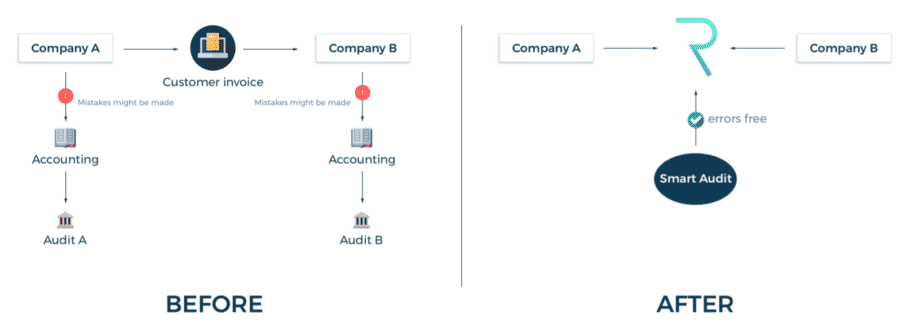
This combination of automation, transparency, and flexibility has made Request valuable for all sorts of teams, no matter the size.
Understanding the REQ Token
While Request Network focuses on simplifying payment infrastructure, the REQ token functions as the operational backbone that keeps everything running smoothly. Rather than serving as the primary transaction currency (i.e., using it to buy a delicious cup of coffee) it works behind the scenes to power the network's various operations.
Every time someone creates or processes a payment request, associated network fees are paid in REQ. These fees are then automatically converted into whichever blockchain currency is needed at that moment (such as ETH for Ethereum network gas fees), allowing Request to operate seamlessly across multiple blockchain ecosystems. Importantly, a portion of the REQ used in these transactions gets burned (or in layman terms, permanently removed from circulation) which creates a natural deflationary pressure over time.
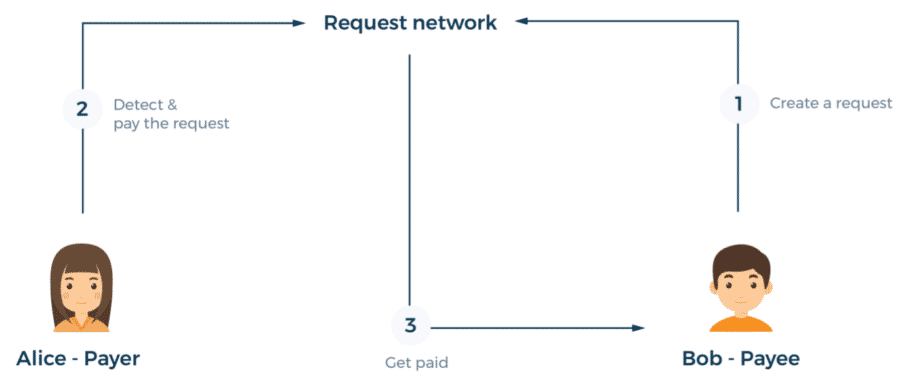
REQ also plays a meaningful role in network governance. Token holders can participate in decisions about protocol upgrades and development priorities. This ensures the network grows through community consensus rather than through centralized decision-making. Moreover, small REQ-based micro-fees help prevent spam and malicious activity by making excessive request creation economically impractical for bad actors.
The token's economic design emphasizes long-term sustainability. With a total supply capped at 1 billion tokens and a relatively decentralized distribution model, the ecosystem sidesteps many of the concentration risks that plague other projects. This structure reduces the likelihood of sudden large-scale token dumps and supports a more stable, resilient market over time.
Why Request Matters in the Crypto Ecosystem
As blockchain technology and the crypto industry as a whole continue to mature, infrastructure projects like Request are becoming increasingly critical to the ecosystem's practical utility. They're not trying to reinvent money itself; they're focused on making financial processes demonstrably smarter.
Who Benefits From Request?
- Major DeFi organizations including Aave, Fantom, and Maker use Request to manage complex multi-token accounting across their operations.
- Traditional enterprises have adopted Request for streamlined tax reporting and regulatory compliance, particularly those operating across multiple jurisdictions.
- Developers rely on Request's API to automate everything from routine payroll processing to recurring subscription billing, eliminating manual intervention.
- Web3 projects leverage Request Finance to manage payments in dozens of different digital assets simultaneously, avoiding the headache of manual conversion and tracking.
The network has also collaborated with Aleo for confidential payroll solutions that maintain compliance while protecting employee financial privacy.
Moreover, Request gained significant mainstream attention in 2021 when The Sandbox (one of the largest NFT gaming platforms) picked Request for its payment infrastructure. This partnership not only drove increased token activity but, more importantly, validated Request as a tool with genuine utility.
Bottom Line
Request shows us what financial infrastructure could be in the Web3 era. It’s transparent, automated, and built for a fast, digital economy. It bridges blockchain's reliability with real-world needs, proving that decentralization is as relevant as it has ever been.
Where to Get REQ
Are you excited about what Request brings to the table? You can get the REQ token directly on the Tap app and start exploring the future of digital payments and invoicing today.
NEWS AND UPDATES
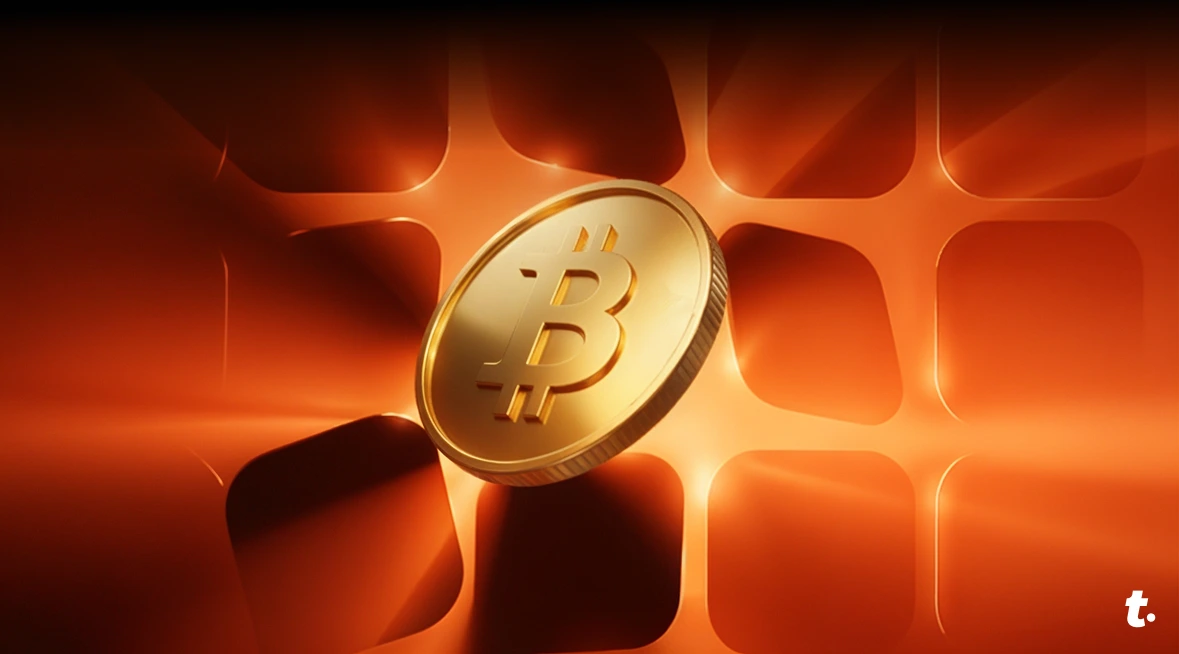
Bitcoin is a long way from reclaiming its all-time high and stuck under $92,000, but three powerful forces could flip the script sooner than you think.
Bitcoin can't seem to catch a break lately. It has been stuck under $92,000 for days and down 17% from the beginning of the month. But if you're wondering when the tide might turn, you're asking the right question. Three catalysts could flip the script, and they're all coming into focus sooner than you think.
The crypto king has been trading sideways since Thursday, frustrating bulls who remember the highs above $110,000 from just four weeks ago. While bears point to softening job numbers and shaky AI investment sentiment, bulls are betting on governments cranking up money printing to cover ballooning deficits. Both camps might be right, and the current weakness could actually be setting the stage for Bitcoin's next major move.
The Inflation Shield Is Back in Play

The iShares TIPS Bond ETF—which tracks Treasury Inflation-Protected Securities—just bounced off support at 110.50 on Thursday and resumed climbing. When this ETF rises, it signals investors are bracing for higher inflation. That's typically good news for Bitcoin, since traders start hunting for alternative hedges against eroding purchasing power.
Meanwhile, interest rate expectations are tightening the screws. According to CME's FedWatch Tool, traders now see a 78% chance the Federal Reserve keeps rates at 3.50% or higher through January 26. That's up dramatically from just 47% in late October. Lower rates usually help leveraged companies breathe easier and boost consumer spending—both positives for risk assets like Bitcoin.

The problem? Uncertainty is everywhere. The US government funding issues that dragged on until November 12 has the Fed thinking twice about any December rate cut. Traders have marked one date on their calendar: the November jobs report dropping December 16.
2026 Could Bring Fireworks
The first half of 2026 is shaping up to be a game-changer. Fed Chair Jerome Powell's term expires in May, and President Donald Trump has been vocal about wanting someone who'll ease up on monetary restrictions. No nomination timeline yet, but Senate confirmation typically takes months—enough time for markets to start pricing in a more dovish stance.
There's more: Bloomberg reported that US regulators just finalized rules slashing capital requirements for major banks starting January 1, 2026. Combined with the Trump administration's push for economic stimulus through expanded borrowing (remember the "One Big Beautiful Bill Act" from July?), these moves could light a fire under risky assets like Bitcoin.
Derivatives Are at a Standstill
Bitcoin options traders aren't feeling confident yet. Put options (bets on price drops) are trading at a 10% premium over equivalent call options (bets on gains)—a clear sign of defensive positioning. With $22.6 billion in BTC options set to expire December 26, most traders are sitting tight until this "skew" normalizes back toward 5% or lower.
The Bottom Line
Bitcoin's path back up remains open, though the timing depends on how these key factors unfold. Inflation expectations are trending upward, regulatory changes for banks could ease financial conditions by early 2026, and potential Fed leadership shifts may signal a less restrictive monetary environment ahead. Meanwhile, derivatives markets suggest traders are waiting for clearer signals before committing to bullish positions.
The December economic data releases and the year-end options expiry will likely influence near-term sentiment, but the more substantial catalysts appear positioned for the first half of 2026. Whether Bitcoin reclaims its recent highs quickly or takes a more gradual path will depend on how these forces interact in the months ahead.
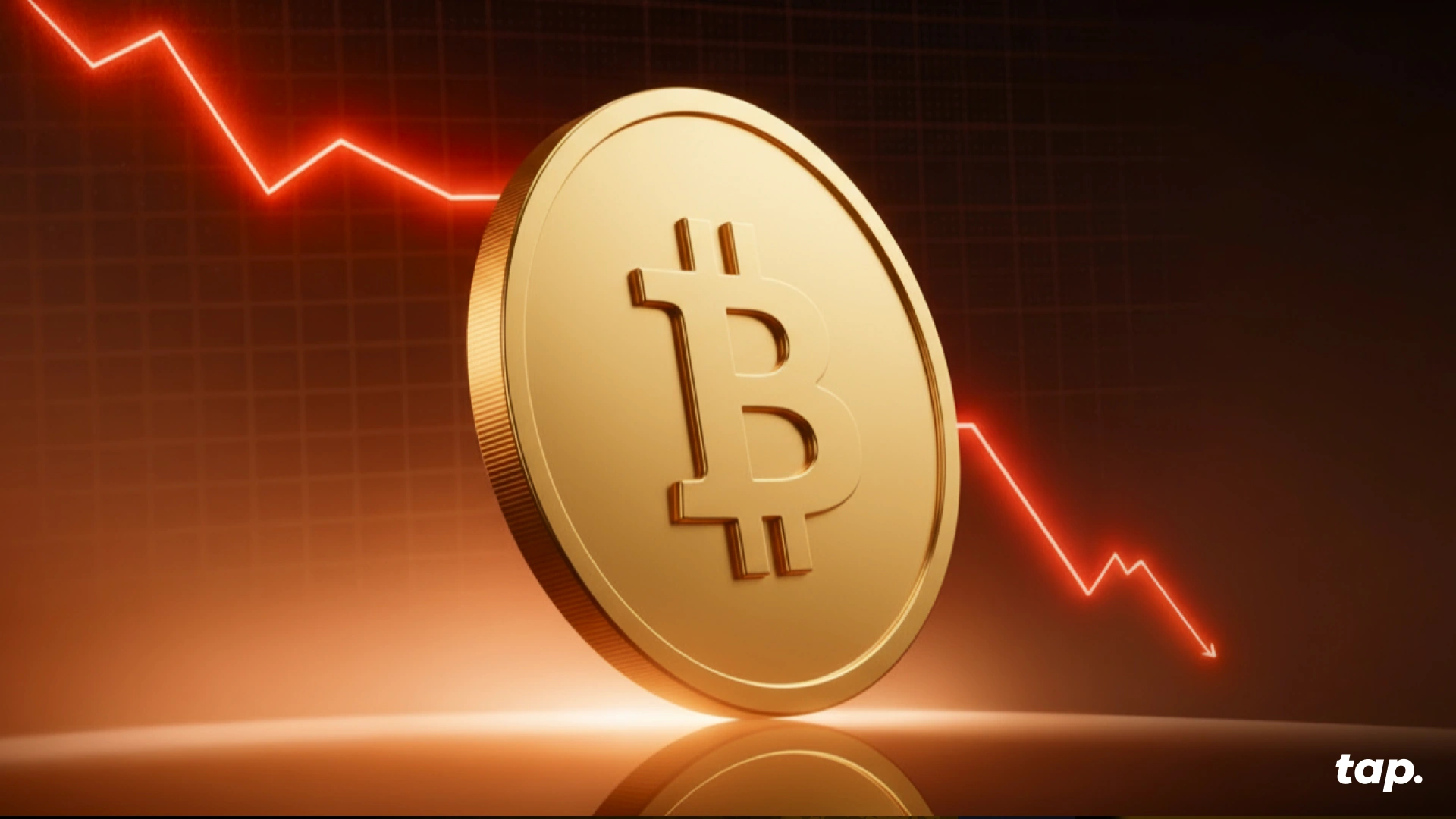
After a brutal October sell-off, crypto just staged one of its most dramatic comebacks yet. Here's what the market's resilience signals for what comes next.
The crypto market just pulled off one of its boldest recoveries in recent memory. What began as a violent sell-off on October 10 has given way to a surprisingly strong rebound. In this piece, we’ll dig into “The Great Recovery” of the crypto market, how Bitcoin’s resilience particularly stands out in this comeback, and what to expect next…
The Crash That Shook It All
On October 10, markets were rattled across the board. Bitcoin fell from around $122,000 down to near $109,000 in a matter of hours. Ethereum dropped into the $3,600 to $3,700 range. The sudden collapse triggered massive liquidations, nearly $19 billion across assets, with $16.7B in long positions wiped out.

That kind of forced selling, often magnified by leverage and thin liquidity, created a sharp vacuum. Some call it a “flash crash”; an overreaction to geopolitical news, margin stress, and cascading liquidations.
What’s remarkable, however, is how quickly the market recovered.
The Great Recovery: Scope and Speed
Within days, many major cryptocurrencies recouped large parts of their losses. Bitcoin climbed back above $115,000, and Ethereum surged more than 8%, reclaiming the $4,100 level and beyond. Altcoins like Cardano and Dogecoin led some of the strongest rebounds.
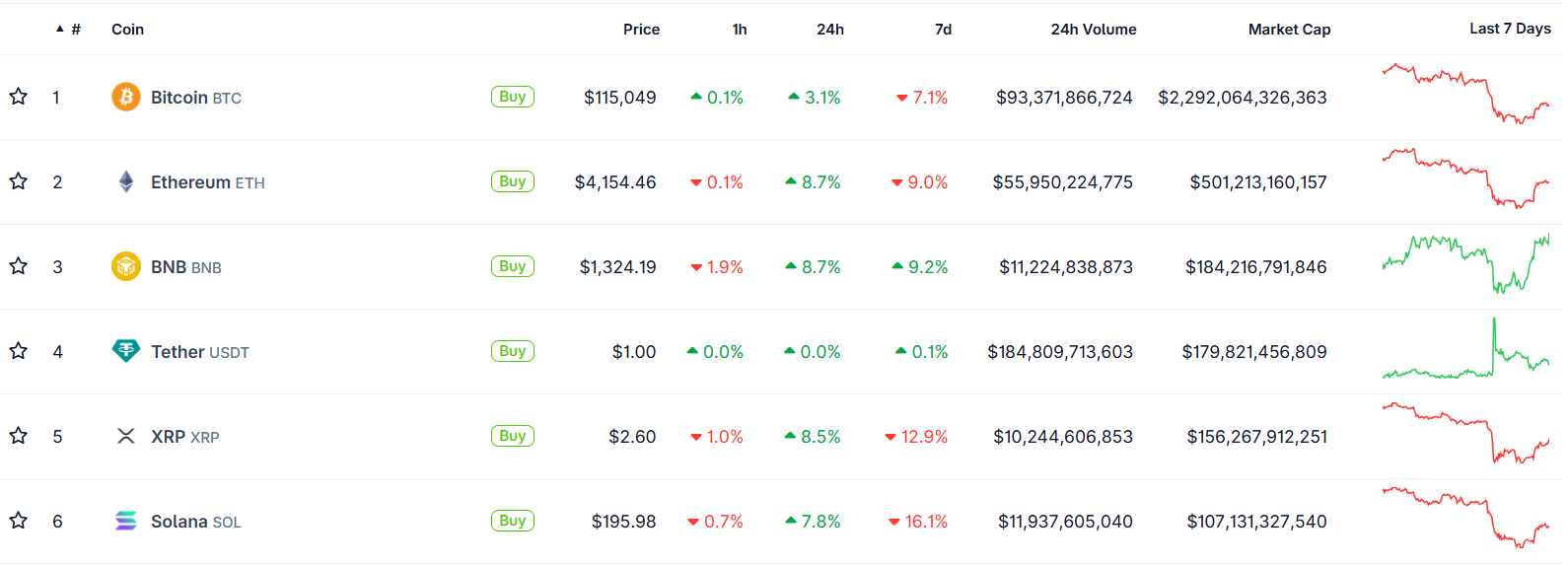
One narrative gaining traction is that this crash was not a structural breakdown but a “relief rally”, a market reset after overleveraged participants were squeezed out of positions. Analysts highlight that sell pressure has eased, sentiment is stabilizing, and capital is re-entering the market, all signs that the broader uptrend may still be intact.
“What we just saw was a massive emotional reset,” Head of Partnerships at Arctic Digital Justin d’Anethan said.

“I would have another, more positive take: seeing 10B worth of liquidation happen in a flash and pushing BTC prices down 15%+ in less than 24hrs to then see BTC recoup 10% to 110K is a testament to how far we've come and how massive and important BTC has become,” he posted on 𝕏.
Moreover, an important datapoint stands out. Exchange inflows to BTC have shrunk, signaling that fewer holders are moving coins to exchanges for sale. This signals that fewer investors are transferring their Bitcoin from personal wallets to exchanges, which is a common precursor to selling. In layman terms, coins are being held rather than prepared for trade.
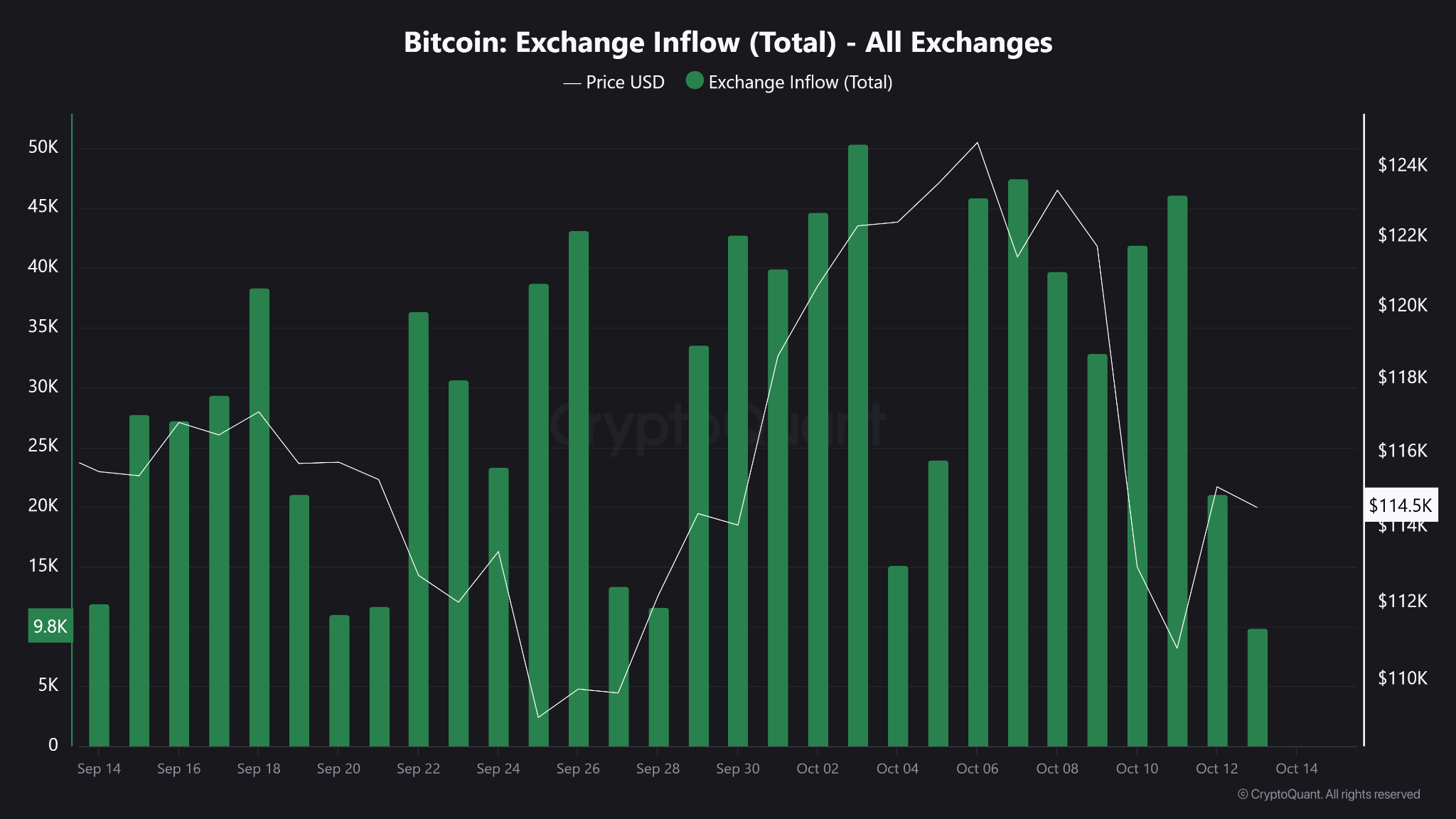
Bitcoin’s Backbone: Resilience Under Pressure
Bitcoin’s ability to rebound after extreme volatility has long been one of its defining traits. Friday’s drop admittedly sent shockwaves through the market, triggering billions in liquidations and exposing the fragility of leveraged trading.
Yet, as history has shown, such sharp pullbacks are far from new for the world’s largest cryptocurrency. In its short history, Bitcoin has endured dozens of drawdowns exceeding 10% in a single day (from the infamous “COVID crash” of 2020 to the FTX collapse in 2022) only to recover and set new highs months later.
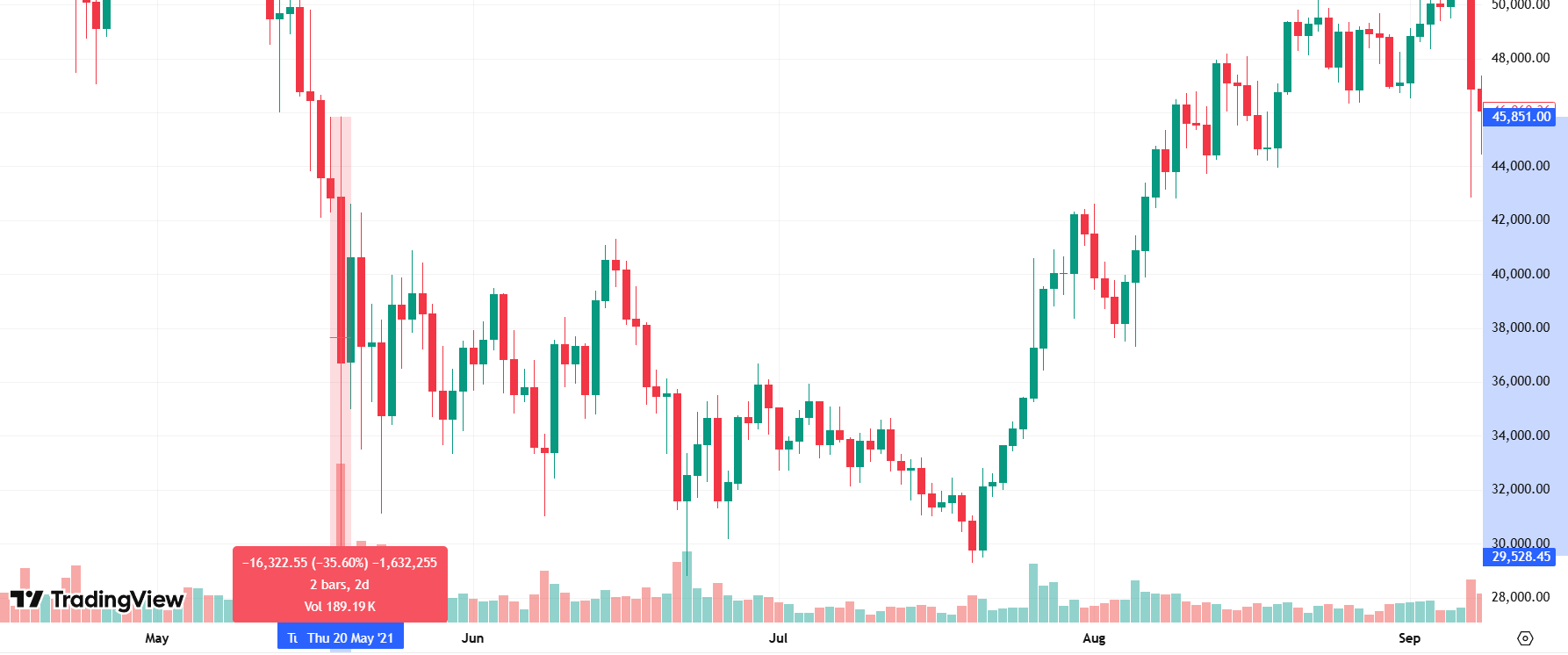
This latest event, while painful, highlights a maturing market structure. Since the approval of spot Bitcoin ETFs in early 2024, institutional involvement has deepened, creating greater liquidity buffers and stronger institutional confidence. Even as billions in leveraged positions were wiped out, Bitcoin has held firm around the $110,000 zone, a level that has since acted as psychological support.
What to Watch Next
The key question now is whether this rebound marks a short-term relief rally or the start of a renewed uptrend. Analysts are closely watching derivatives funding rates, on-chain flows, and ETF inflows for clues. A sustained increase in ETF demand could provide a steady bid under the market, offsetting the effects of future liquidation cascades. Meanwhile, Bitcoin’s ability to hold above $110,000 (an area of heavy trading volume) may serve as confirmation that investor confidence remains intact.
As the market digests the events of October 10, one lesson stands out. Bitcoin’s recovery isn’t just a matter of luck, it’s a reflection of underlying market structure that can absorb shocks. It is built on a growing base of long-term holders, institutional adoption, and a financial system increasingly intertwined with digital assets. Corrections, however dramatic, are not signs of weakness; they are reminders of a maturing market that is striding towards equilibrium.
Bottom Line
The crash on October 10 was brutal, there’s no denying that. It was one of the deepest and fastest in recent memory. But the recovery has been equally sharp. Rather than exposing faults, the rebound has underscored the market’s adaptability and Bitcoin’s central role.
The market consensus is seemingly leaning towards a reset; not a reversal. The shakeout purged excess leverage, and the comeback underlined demand. If Bitcoin can maintain that strength, and the broader market keeps its footing in the coming days, this could mark a turning point rather than a cave-in.

What's driving the crypto market this week? Get fast, clear updates on the top coins, market trends, and regulation news.
Welcome to Tap’s weekly crypto market recap.
Here are the biggest stories from last week (8 - 14 July).
💥 Bitcoin breaks new ATH
Bitcoin officially hit above $122,000 marking its first record since May and pushing total 2025 gains to around +20% YTD. The rally was driven by heavy inflows into U.S. spot ETFs, over $218m into BTC and $211m into ETH in a single day, while nearly all top 100 coins turned green.
📌 Trump Media files for “Crypto Blue‑Chip ETF”
Trump Media & Technology Group has submitted an S‑1 to the SEC for a new “Crypto Blue Chip ETF” focused primarily on BTC (70%), ETH (15%), SOL (8%), XRP (5%), and CRO (2%), marking its third crypto ETF push this year.
A major political/media player launching a multi-asset crypto fund signals growing mainstream and institutional acceptance, and sparks fresh conflict-of-interest questions. We’ll keep you updated.
🌍 Pakistan launches CBDC pilot & virtual‑asset regulation
The State Bank of Pakistan has initiated a pilot for a central bank digital currency and is finalising virtual-asset laws, with Binance CEO CZ advising government efforts. With inflation at just 3.2% and rising foreign reserves (~$14.5b), Pakistan is embracing fintech ahead of emerging-market peers like India.
🛫 Emirates Airline to accept crypto payments
Dubai’s Emirates signed a preliminary partnership with Crypto.com to enable crypto payments starting in 2026, deepening the Gulf’s commitment to crypto-friendly infrastructure.
*Not to take away from the adoption excitement, but you can book Emirates flights with your Tap card, using whichever crypto you like.
🏛️ U.S. declares next week “Crypto Week”
House Republicans have designated 14-18 July as “Crypto Week,” aiming for votes on GENIUS (stablecoin oversight), CLARITY (jurisdiction clarity), and Anti‑CBDC bills. The idea is that these bills could reshape how U.S. defines crypto regulation and limit federal CBDC initiatives under Trump-aligned priorities.
Stay tuned for next week’s instalment, delivered on Monday mornings.

Explore why Bitcoin and the crypto market are worth $2.1 trillion and why skepticism still lingers among Americans in this deep dive.
Decoding the disconnect: America's cautious approach to crypto
Bitcoin and the broader crypto market have soared to a staggering $2.1 trillion in value, but why does skepticism still linger among so many Americans?
Despite increasing adoption, digital currencies remain shrouded in doubt, revealing a significant trust gap that continues to challenge the industry. As cryptocurrencies become more woven into everyday financial transactions, closing this trust deficit is essential for ensuring sustained growth and mainstream acceptance.
In this article, we'll dive into the key reasons behind this persistent mistrust, uncover the expanding real-world uses of digital assets, and explore how education and technological advancements can help bridge the confidence gap. Keep in mind, the data presented draws from multiple studies, so some figures and age groupings may vary slightly.
A Look at the Current State of Crypto Trust
To truly understand cryptocurrency adoption and the accompanying trust issues, it’s essential to examine the latest statistics and demographic data. This section breaks down public sentiment toward crypto and provides a snapshot of its user base.
General Public Sentiment
Percentage of Americans Who Own Cryptocurrency
Cryptocurrency adoption has seen slow but steady growth over the years. According to surveys conducted by Pew Research Center in 2021 and 2023, 17% of Americans have invested in, traded, or used cryptocurrency, up slightly from 16% in 2021.
While estimates vary, Security.org places this figure higher, estimating that roughly 40% of the U.S. population - around 93 million adults - own some form of cryptocurrency.
Both studies agree that younger generations are driving much of this growth, with 30% of Americans aged 18-29 reporting they have experience with crypto.
Trust Levels in Cryptocurrency
Despite rising adoption rates, trust in cryptocurrency remains a significant hurdle. Pew Research Center found that 75% of Americans have little or no confidence that cryptocurrency exchanges can safeguard their funds. Similarly, a recent report by Morning Consult shows that 7 in 10 consumers familiar with crypto express low or no trust in it.
This contrasts the 31% who have some or high trust, or the 24% in the Pew study who are “somewhat” to “extremely” confident in cryptocurrencies.
Demographics of Crypto Adopters
- Age Groups
Cryptocurrency adoption trends reveal a distinct generational divide. According to the 2023 Morning Consult survey, Gen Z adults (ages 18-25) lead in crypto ownership at 36%, closely followed by Millennials at 30%.
These younger groups are also more inclined toward future investments, with 39% of Gen Z and 45% of Millennials planning to invest in crypto in the coming years. Over half of both generations view cryptocurrency and blockchain as the future, while a notable percentage (27% of Gen Z and 21% of Millennials) considered opening an account with a crypto exchange in the past year.
When compared to other asset classes, data from Bankrate’s 2021 survey reveals that younger Millennials (ages 25-31) favor real estate and stock market investments, while Baby Boomers have the least interest in cryptocurrency. Older Millennials (32-40) lean toward cash investments, with cryptocurrency’s appeal steadily declining with age.
Interestingly, the report also highlights gender differences, showing that 80% of women familiar with crypto express low confidence, compared to 71% of men, indicating a broader trust gap among female users.
- Income Levels
Contrary to common assumptions, cryptocurrency adoption is not confined to high-income individuals. The same Pew Research Center survey revealed that crypto ownership is relatively evenly spread across income brackets:
- 13% of those earning less than $56,600 annually own crypto.
- 19% of those earning between $56,600 and $169,800 own crypto.
- 22% of those earning over $169,800 own crypto.
This data suggests that while higher earners may be more inclined to own cryptocurrency, the appeal of digital assets spans various income levels.
- Educational Background
Education also plays a role in crypto adoption. A 2022 report by Triple-A found that the majority of crypto owners are “highly educated”:
- 24% of crypto owners have graduated from middle or high school.
- 10% have some vocational or college education.
- 39% are college graduates.
- 27% hold postgraduate degrees.
This shows that while those with some college education or a degree are more likely to own crypto, it is not exclusively a pursuit of the highly educated.
This demographic data paints a picture of cryptocurrency adopters as predominantly younger, spread across a range of income levels, and with diverse educational backgrounds. However, the trust gap between crypto and traditional financial systems remains a significant barrier to wider acceptance of digital assets.
Key Trust Barriers
To bridge the gap between cryptocurrency adoption and trust, it’s crucial to understand the major concerns fueling skepticism. This section explores these concerns and contrasts them with similar risks in traditional financial systems.
The Primary Concerns of Skeptics
Volatility
One of the most significant barriers to cryptocurrency adoption is its notorious volatility, particularly for investors seeking stable, long-term assets. Bitcoin, the most well-known cryptocurrency, symbolizes this risk.
In 2022, Bitcoin’s volatility was stark. Its 30-day volatility reached 64.02% in June, driven by broader economic uncertainty and market downturns, compared to the S&P 500’s much lower volatility of 4.71% during the same period.
Over the course of the year, Bitcoin’s price swung from a peak of $47,835 to a low of $18,490, marking a substantial 61% decline from its highest point in 2022. Factors such as rising interest rates, geopolitical tensions, and major crypto market disruptions, like the TerraUSD collapse and Celsius’ liquidity crisis, played a pivotal role.
This extreme volatility reinforces the perception of cryptocurrencies as high-risk investments.
However, traditional stock markets, while typically more stable than crypto, can also experience sharp fluctuations, especially in times of economic stress. For instance, the CBOE Volatility Index (VIX), which measures expected near-term volatility in the U.S. stock market, dropped by 23% to 28.71 on June 30, 2022, far below the 82.69 peak recorded during the early COVID-19 market turbulence in March 2020. This shows that even stock markets, generally seen as safer, can experience moments of intense volatility, particularly during global crises.
Additionally, when compared to the "Magnificent Seven" (a group of top-performing and influential stocks) Bitcoin’s volatility doesn't stand out as unusual. In fact, over the past two years, Bitcoin has shown less volatility than Netflix (NFLX) stock.
On a 90-day timeframe, NFLX had an average realized volatility of 53%, while Bitcoin’s was slightly lower at 46%. The reality is that among all S&P 500 companies, Bitcoin has demonstrated lower annualized historical volatility than 33 of the 503 constituents.
In October 2023, Bitcoin was actually less volatile than 92 stocks in the S&P 500, based on 90-day realized historical volatility figures, including some large-cap and mega-cap companies.
Security
Security concerns are another major hurdle in building trust with cryptocurrencies. Cryptocurrency exchanges and wallets have been targeted by numerous high-profile hacks and frauds, raising doubts about the safety of digital assets. It comes as no surprise that a study from Morning Consult found that 67% of Americans believe having a secure and trustworthy platform is essential to entering the crypto market.
While security threats in the crypto space are well-documented, traditional banking systems are not immune to fraud either. Federal Trade Commission data reveals that consumer fraud losses in the traditional financial sector hit a record high of $10 billion in 2023, marking a 14% increase from the previous year.
Although traditional banks have more safeguards in place to protect consumers, they remain vulnerable to attacks, showing that security is a universal challenge across both crypto and traditional finance.
Prevention remains key, which in this case equates to using only reliable platforms or hardwallets.
Regulatory Uncertainty
Regulatory ambiguity continues to be a critical barrier for both cryptocurrency investors and businesses. The evolving landscape creates uncertainty about the future of digital assets.
Currently, cryptocurrency is legal in 119 countries and four British Overseas Territories, covering more than half of the world’s nations. Notably, 64.7% of these countries are emerging and developing economies, primarily in Asia and Africa.
However, only 62 of these 119 countries (52.1%) have comprehensive regulations in place. This represents significant growth from 2018, when only 33 jurisdictions had formal regulations, showing a 53.2% increase, but still falls short in creating a sense of “unified safety”.
In the United States, regulatory views remain fragmented. Various agencies, such as the Securities and Exchange Commission (SEC) and the Commodity Futures Trading Commission (CFTC), have conflicting perspectives on how to classify and regulate cryptocurrencies. Since 2019, the SEC has filed over 116 crypto-related lawsuits, adding to the regulatory uncertainty faced by the industry.
The Growing Integration Of Digital Assets In Daily Life
As we progress further into the digital age, cryptocurrencies and digital assets are increasingly becoming part of our everyday financial transactions. This shift is driven by two key developments: the rise of crypto payment options and the growing adoption of Central Bank Digital Currencies (CBDCs).
According to a MatrixPort report, global cryptocurrency adoption has now reached 7.51% of the population, underscoring the expanding influence of digital currencies worldwide. By 2025, this rate is expected to surpass 8%, signaling a potential shift from niche usage to mainstream acceptance.
The list of major retailers embracing cryptocurrency as a payment method continues to grow. Some notable companies now accepting crypto include:
- Microsoft: Accepts Bitcoin for Xbox store credits.
- AT&T: The first major U.S. mobile carrier to accept crypto payments.
- Whole Foods: Accepts Bitcoin via the Spedn app.
- Overstock: One of the first major retailers to accept Bitcoin.
- Starbucks: Allows customers to load their Starbucks cards with Bitcoin through the Bakkt app.
A 2022 Deloitte survey revealed that nearly 75% of retailers plan to accept either cryptocurrency or stablecoin payments within the next two years. This trend highlights the growing mainstream acceptance of digital assets as a legitimate payment method.
Crypto-backed debit cards are further bridging the gap between digital assets and everyday transactions. These cards enable users to spend their cryptocurrency at any merchant that accepts traditional debit cards.
According to Factual Market Research, the global crypto card market is projected to reach $9.5 billion by 2030, with a compound annual growth rate (CAGR) of approximately 31.6% from 2021 to 2030. This growth reflects the increasing popularity of crypto-backed debit cards as a way for consumers to integrate their digital assets into daily spending.
The Rise of Central Bank Digital Currencies (CBDCs)
Central Bank Digital Currencies (CBDCs) represent digital versions of a country’s fiat currency, issued and regulated by the national monetary authority. In 2024, the global progress of CBDCs has seen a significant uptick, with marked advances in both research and adoption. As of this year:
- 11 countries have fully launched CBDCs, including the Bahamas, Nigeria, Jamaica, and China.
- 44 countries are conducting pilot programs, up from 36, reflecting growing interest in testing the functionality and stability of digital currencies.
- 66 nations are at advanced stages of CBDC development, contributing to a global landscape where 134 countries (accounting for 98% of the world’s economy) are engaged in CBDC projects.
In the United States, the Federal Reserve is exploring the feasibility of a CBDC through Project Hamilton, a collaborative research initiative with MIT. This exploration aligns with broader goals to reduce reliance on cash, enhance financial inclusion, and improve control over national monetary systems amid the rise of digital payments and cryptocurrencies.
The introduction of CBDCs could significantly reshape daily financial transactions in several ways:
- Increased financial inclusion: CBDCs could offer digital payment access to the 1.4 billion adults who remain unbanked, according to World Bank estimates.
- Faster and cheaper transactions: CBDCs could streamline both domestic and cross-border payments, reducing costs and settlement times.
- Enhanced monetary policy: Central banks would gain more direct control over money supply and circulation.
- Improved traceability: CBDCs could help combat financial crimes and reduce tax evasion by providing greater transaction transparency.
However, challenges persist, including concerns about privacy, cybersecurity risks, and the potential disruption of existing banking systems.
As digital assets continue to integrate into everyday life, they hold the potential to transform how we think about and use money. Despite these challenges, trends in both private cryptocurrency adoption and CBDC development point to a future where digital assets play a central role in our financial systems.
Building Trust Through Technology and Education
According to the 2023 Web3 UI/UX Report, nearly 48% of users cite security concerns and asset protection as the primary barriers to crypto adoption. Other challenges include high transaction fees and the steep learning curve needed to fully grasp both the technology and its benefits.
Despite these obstacles, the blockchain sector has made significant strides as it matures, particularly in enhancing security. Hack-related losses in the crypto market dropped from $3.7 billion in 2022 to $1.8 billion in 2023, underscoring the progress in safeguarding digital assets.
The increased adoption of offline hardware wallets and multi-signature wallets, both of which add critical layers of security, reflects this momentum. Advances in smart contract auditing tools and stronger compliance standards are also minimizing risks, creating a safer environment for both users and institutions.
These improvements highlight the industry’s commitment to establishing a more secure foundation for digital transactions and bolstering confidence in blockchain as a reliable financial technology.
In another positive development, in May 2023, the European Council approved the first comprehensive legal framework for the cryptocurrency industry. This legislation sets a new standard for regulatory transparency and oversight, further reinforcing trust.
Financial Literacy Initiatives
The rise of crypto education in the U.S. is playing a pivotal role in increasing public understanding and encouraging adoption. Programs such as Coinbase Earn aim to simplify the onboarding process for new users, directly addressing the complexity and security concerns that often deter people from engaging with crypto.
According to recent data, 43% of respondents feel that insufficient knowledge is a key reason they avoid the sector, highlighting the ongoing need for crypto-related learning.
Additionally, Chainalysis' 2024 Global Crypto Adoption Index noted a significant increase in crypto interest following the launch of spot Bitcoin ETFs in the U.S. earlier in the year. This development enabled investors to trade ETF shares tied to Bitcoin directly on stock exchanges, making it easier to enter the market without needing extensive technical expertise - thus driving a surge in adoption.
These advancements in security and education are gradually fostering greater trust in the cryptocurrency ecosystem. As the sector continues to evolve, these efforts may pave the way for broader adoption and deeper integration of digital assets into daily financial life.
The Future of Digital Asset Adoption
As digital assets continue to evolve and capture mainstream attention, their potential to transform the financial landscape is becoming increasingly evident. From late 2023 through early 2024, global crypto transaction volumes surged, surpassing the peaks of the 2021 bull market (as illustrated below).
Interestingly, much of this growth in adoption was driven by lower-middle income countries, highlighting the global reach of digital assets.
Below, we explore projections for cryptocurrency usage and its potential impact on traditional banking and finance.
Projections for Crypto Usage in the Next 5-10 Years
Several studies and reports offer insights into the expected growth of cryptocurrency over the next decade:
Global Adoption
The global cryptocurrency market revenue is projected to reach approximately $56.7 billion in 2024, with the United States leading the charge, expected to generate around $9.8 billion in revenue. Statista predicts the number of global crypto users will hit 861 million by 2025, marking a significant shift toward mainstream use.
Institutional Adoption
The 2023 Institutional Investor Digital Assets Study found that 65% of the 1,042 institutional investors surveyed plan to buy or invest in digital assets in the future.
As of 2024, digital currency usage among U.S. organisations is expanding, particularly in sectors such as finance, retail, and technology. Hundreds of financial services and fintech firms are now involved in digital assets, whether in payment processing, investments, or blockchain-based applications. This includes major companies utilising cryptocurrencies as stored value and exploring stablecoin use cases to enhance transaction efficiency.
Notably, major U.S. companies are increasingly engaging with blockchain and digital assets, as regulatory clarity improves and security concerns are addressed.
Retail Adoption
At present, about 85% of major retailers generating over $1 billion in annual online sales accept cryptocurrency payments. In contrast, 23% of mid-sized retailers, with online sales between $250 million and $1 billion, currently accept crypto payments. This growing trend points to an expanding role for digital assets in retail, especially among large-scale businesses.
Potential Impact on Traditional Banking and Finance
The rise of digital asset utilisation is poised to reshape traditional banking systems in multiple areas. For starters, the growth of blockchain technology and digitised financial services is driving the decentralised finance (DeFi) market, which is projected to reach $450 billion by 2030, with a compound annual growth rate (CAGR) of 46%.
In Q3 2024 alone, trading on decentralised exchanges surpassed $100 billion, marking the third consecutive month of growth in trading volume. This trend underscores the increasing interest and activity in the decentralised finance space.
As Central Bank Digital Currencies (CBDCs) are likely to be adopted by 80% of central banks by 2030, the role of commercial banks in money distribution could diminish significantly. Meanwhile, blockchain technology and stablecoins are expected to revolutionise cross-border B2B payments, with 20% of these transactions powered by blockchain by 2025. Stablecoin payment volumes are projected to hit $620 billion by 2026.
Furthermore, the investment landscape is set to evolve as asset tokenisation scales, potentially reaching a value of $16 trillion, making crypto a standard component in investment portfolios.
With regulatory clarity expected to improve - more than half of financial institutions anticipate clearer rules within the next three years - crypto integration is likely to become more widespread. These developments emphasise the transformative potential of digital assets across payments, investments, and financial structures globally.
Bridging the trust gap in crypto adoption
The cryptocurrency landscape is experiencing a surge in institutional interest, which could be a pivotal moment for integrating digital assets into traditional finance. Financial giants like BlackRock are at the forefront of this movement, signaling a shift in mainstream perception and adoption of cryptocurrencies.
Historically, the introduction of new investment vehicles around Bitcoin has spurred market growth. As Markus Thielen, founder of 10x Research, highlights, the launch of spot ETFs could bring about a new wave of institutional involvement, potentially driving the next phase of market expansion.
This growing institutional momentum, combined with evolving regulatory frameworks, is reshaping the crypto ecosystem. However, a key question remains: Will these developments be enough to close the trust gap and push cryptocurrencies into mainstream adoption?
As we stand at this crossroads, the future of digital assets hangs in the balance. The coming years will be critical in determining whether cryptocurrencies can overcome persistent skepticism and fully integrate into the global financial system, or if they will remain a niche, yet impactful, financial instrument.

Explore key catalysts driving the modern money revolution. Learn about digital currencies, fintech innovation, and the future of finance.
The financial world is undergoing a significant transformation, largely driven by Millennials and Gen Z. These digital-native generations are embracing cryptocurrencies at an unprecedented rate, challenging traditional financial systems and catalysing a shift toward new forms of digital finance, redefining how we perceive and interact with money.
This movement is not just a fleeting trend but a fundamental change that is redefining how we perceive and interact with money.
Digital Natives Leading the Way
Growing up in the digital age, Millennials (born 1981-1996) and Gen Z (born 1997-2012) are inherently comfortable with technology. This familiarity extends to their financial behaviours, with a noticeable inclination toward adopting innovative solutions like cryptocurrencies and blockchain technology.
According to the Grayscale Investments and Harris Poll Report which studied Americans, 44% agree that “crypto and blockchain technology are the future of finance.” Looking more closely at the demographics, Millenials and Gen Z’s expressed the highest levels of enthusiasm, underscoring the pivotal role younger generations play in driving cryptocurrency adoption.
Desire for Financial Empowerment and Inclusion
Economic challenges such as the 2008 financial crisis and the impacts of the COVID-19 pandemic have shaped these generations' perspectives on traditional finance. There's a growing scepticism toward conventional financial institutions and a desire for greater control over personal finances.
The Grayscale-Harris Poll found that 23% of those surveyed believe that cryptocurrencies are a long-term investment, up from 19% the previous year. The report also found that 41% of participants are currently paying more attention to Bitcoin and other crypto assets because of geopolitical tensions, inflation, and a weakening US dollar (up from 34%).
This sentiment fuels engagement with cryptocurrencies as viable investment assets and tools for financial empowerment.
Influence on Market Dynamics
The collective financial influence of Millennials and Gen Z is significant. Their active participation in cryptocurrency markets contributes to increased liquidity and shapes market trends. Social media platforms like Reddit, Twitter, and TikTok have become pivotal in disseminating information and investment strategies among these generations.
The rise of cryptocurrencies like Dogecoin and Shiba Inu demonstrates how younger investors leverage online communities to impact financial markets2. This phenomenon shows their ability to mobilise and drive market movements, challenging traditional investment paradigms.
Embracing Innovation and Technological Advancement
Cryptocurrencies represent more than just investment opportunities; they embody technological innovation that resonates with Millennials and Gen Z. Blockchain technology and digital assets are areas where these generations are not only users but also contributors.
A 2021 survey by Pew Research Center indicated that 31% of Americans aged 18-29 have invested in, traded, or used cryptocurrency, compared to just 8% of those aged 50-64. This significant disparity highlights the generational embrace of digital assets and the technologies underpinning them.
Impact on Traditional Financial Institutions
The shift toward cryptocurrencies is prompting traditional financial institutions to adapt. Banks, investment firms, and payment platforms are increasingly integrating crypto services to meet the evolving demands of younger clients.
Companies like PayPal and Square have expanded their cryptocurrency offerings, allowing users to buy, hold, and sell cryptocurrencies directly from their platforms. These developments signify the financial industry's recognition of the growing importance of cryptocurrencies.
Challenges and Considerations
While enthusiasm is high, challenges such as regulatory uncertainties, security concerns, and market volatility remain. However, Millennials and Gen Z appear willing to navigate these risks, drawn by the potential rewards and alignment with their values of innovation and financial autonomy.
In summary
Millennials and Gen Z are redefining the financial landscape, with their embrace of cryptocurrencies serving as a catalyst for broader change. This isn't just about alternative investments; it's a shift in how younger generations view financial systems and their place within them. Their drive for autonomy, transparency, and technological integration is pushing traditional institutions to innovate rapidly.
This generational influence extends beyond personal finance, potentially reshaping global economic structures. For industry players, from established banks to fintech startups, adapting to these changing preferences isn't just advantageous—it's essential for long-term viability.
As cryptocurrencies and blockchain technology mature, we're likely to see further transformations in how society interacts with money. Those who can navigate this evolving landscape, balancing innovation with stability, will be well-positioned for the future of finance. It's a complex shift, but one that offers exciting possibilities for a more inclusive and technologically advanced financial ecosystem. The financial world is changing, and it's the young guns who are calling the shots.
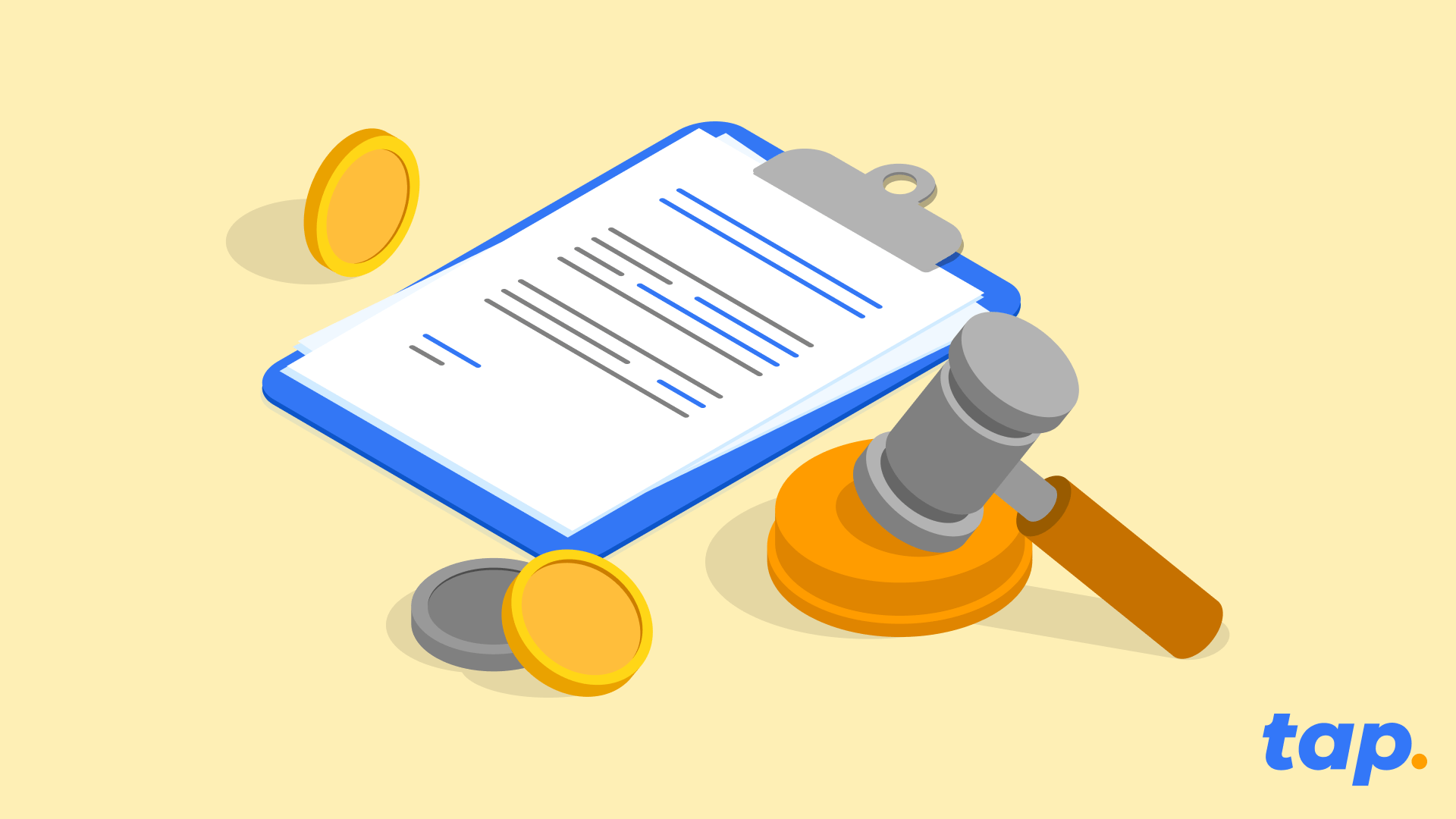
You might have heard of the "Travel Rule" before, but do you know what it actually mean? Let us dive into it for you.
What is the "Travel Rule"?
You might have heard of the "Travel Rule" before, but do you know what it actually mean? Well, let me break it down for you. The Travel Rule, also known as FATF Recommendation 16, is a set of measures aimed at combating money laundering and terrorism financing through financial transactions.
So, why is it called the Travel Rule? It's because the personal data of the transacting parties "travels" with the transfers, making it easier for authorities to monitor and regulate these transactions. See, now it all makes sense!
The Travel Rule applies to financial institutions engaged in virtual asset transfers and crypto companies, collectively referred to as virtual asset service providers (VASPs). These VASPs have to obtain and share "required and accurate originator information and required beneficiary information" with counterparty VASPs or financial institutions during or before the transaction.
To make things more practical, the FATF recommends that countries adopt a de minimis threshold of 1,000 USD/EUR for virtual asset transfers. This means that transactions below this threshold would have fewer requirements compared to those exceeding it.
For transfers of Virtual Assets falling below the de minimis threshold, Virtual Asset Service Providers (VASPs) are required to gather:
- The identities of the sender (originator) and receiver (beneficiary).
- Either the wallet address associated with each transaction involving Virtual Assets (VAs) or a unique reference number assigned to the transaction.
- Verification of this gathered data is not obligatory, unless any suspicious circumstances concerning money laundering or terrorism financing arise. In such instances, it becomes essential to verify customer information.
Conversely, for transfers surpassing the de minimis threshold, VASPs are obligated to collect more extensive particulars, encompassing:
- Full name of the sender (originator).
- The account number employed by the sender (originator) for processing the transaction, such as a wallet address.
- The physical (geographical) address of the sender (originator), national identity number, a customer identification number that uniquely distinguishes the sender to the ordering institution, or details like date and place of birth.
- Name of the receiver (beneficiary).
- Account number of the receiver (beneficiary) utilized for transaction processing, similar to a wallet address.
By following these guidelines, virtual asset service providers can contribute to a safer and more transparent virtual asset ecosystem while complying with international regulations on anti-money laundering and countering the financing of terrorism. It's all about ensuring the integrity of financial transactions and safeguarding against illicit activities.
Implementation of the Travel Rule in the United Kingdom
A notable shift is anticipated in the United Kingdom's oversight of the virtual asset sector, commencing September 1, 2023.
This seminal development comes in the form of the Travel Rule, which falls under Part 7A of the Money Laundering Regulations 2017. Designed to combat money laundering and terrorist financing within the virtual asset industry, this new regulation expands the information-sharing requirements for wire transfers to encompass virtual asset transfers.
The HM Treasury of the UK has meticulously customized the provisions of the revised Wire Transfer Regulations to cater to the unique demands of the virtual asset sector. This underscores the government's unwavering commitment to fostering a secure and transparent financial ecosystem. Concurrently, it signals their resolve to enable the virtual asset industry to flourish.
The Travel Rule itself originates from the updated version of the Financial Action Task Force's recommendation on information-sharing requirements for wire transfers. By extending these recommendations to cover virtual asset transfers, the UK aspires to significantly mitigate the risk of illicit activities within the sector.
Undoubtedly, the Travel Rule heralds a landmark stride forward in regulating the virtual asset industry in the UK. By extending the ambit of information-sharing requirements and fortifying oversight over virtual asset firms
Implementation of the Travel Rule in the European Union
Prepare yourself, as a new regulation called the Travel Rule is set to be introduced in the world of virtual assets within the European Union. Effective from December 30, 2024, this rule will take effect precisely 18 months after the initial enforcement of the Transfer of Funds Regulation.
Let's delve into the details of the Travel Rule. When it comes to information requirements, there will be no distinction made between cross-border transfers and transfers within the EU. The revised Transfer of Funds regulation recognizes all virtual asset transfers as cross-border, acknowledging the borderless nature and global reach of such transactions and services.
Now, let's discuss compliance obligations. To ensure adherence to these regulations, European Crypto Asset Service Providers (CASPs) must comply with certain measures. For transactions exceeding 1,000 EUR with self-hosted wallets, CASPs are obligated to collect crucial originator and beneficiary information. Additionally, CASPs are required to fulfill additional wallet verification obligations.
The implementation of these measures within the European Union aims to enhance transparency and mitigate potential risks associated with virtual asset transfers. For individuals involved in this domain, it is of utmost importance to stay informed and adhere to these new guidelines in order to ensure compliance.
What does the travel rules means to me as user?
As a user in the virtual asset industry, the implementation of the Travel Rule brings some significant changes that are designed to enhance the security and transparency of financial transactions. This means that when you engage in virtual asset transfers, certain personal information will now be shared between the involved parties. While this might sound intrusive at first, it plays a crucial role in combating fraud, money laundering, and terrorist financing.
The Travel Rule aims to create a safer environment for individuals like you by reducing the risks associated with illicit activities. This means that you can have greater confidence in the legitimacy of the virtual asset transactions you engage in. The regulation aims to weed out illicit activities and promote a level playing field for legitimate users. This fosters trust and confidence among users, attracting more participants and further driving the growth and development of the industry.
However, it's important to note that complying with this rule may require you to provide additional information to virtual asset service providers. Your privacy and the protection of your personal data remain paramount, and service providers are bound by strict regulations to ensure the security of your information.
In summary, the Travel Rule is a positive development for digital asset users like yourself, as it contributes to a more secure and trustworthy virtual asset industry.
Unlocking Compliance and Seamless Experiences: Tap's Proactive Approach to Upcoming Regulations
Tap is fully committed to upholding regulatory compliance, while also prioritizing a seamless and enjoyable customer experience. In order to achieve this delicate balance, Tap has proactively sought out partnerships with trusted solution providers and is actively engaged in industry working groups. By collaborating with experts in the field, Tap ensures it remains on the cutting edge of best practices and innovative solutions.
These efforts not only demonstrate Tap's dedication to compliance, but also contribute to creating a secure and transparent environment for its users. By staying ahead of the curve, Tap can foster trust and confidence in the cryptocurrency ecosystem, reassuring customers that their financial transactions are safe and protected.
But Tap's commitment to compliance doesn't mean sacrificing user experience. On the contrary, Tap understands the importance of providing a seamless journey for its customers. This means that while regulatory requirements may be changing, Tap is working diligently to ensure that users can continue to enjoy a smooth and hassle-free experience.
By combining a proactive approach to compliance with a determination to maintain user satisfaction, Tap is setting itself apart as a trusted leader in the financial technology industry. So rest assured, as Tap evolves in response to new regulations, your experience as a customer will remain top-notch and worry-free.

Tap makes entering the Bitcoin world simple. Buy, sell, hold, and trade Bitcoin easily on our secure platform.
Welcome to this week's Crypto Update, your go-to destination for the latest news in the exciting world of cryptocurrencies. Let's dive right into the highlights of the past week in the dynamic crypto market.
Etherscan's AI Tool for Smart Contracts:
Etherscan has launched Code Reader, an advanced tool that utilizes AI to retrieve and interpret source code from specific Ethereum contract addresses. Code Reader leverages OpenAI's powerful language model to generate comprehensive insights into contract source code files. The tool allows users to gain a deeper understanding of contract code, access comprehensive lists of smart contract functions, and explore contract interactions with decentralized applications. To access and utilize Code Reader, users need a valid OpenAI API Key and sufficient OpenAI usage limits. However, researchers caution about the challenges posed by current AI models, including computing power limitations, data synchronization, network optimization, and privacy concerns.
SEC's increased scrutiny on cryptocurrencies sparks debate:
The U.S. Securities and Exchange Commission's (SEC) increased scrutiny has led to a prominent debate concerning the future of XRP and Ethereum. Max Keiser, a well-known Bitcoin advocate, predicts the downfall of XRP and Ethereum due to regulatory overreach. In contrast, John Deaton, representing XRP holders, opposes this view, arguing for a more balanced regulatory approach. The cryptocurrency community is now anxiously awaiting regulatory clarity, as the SEC's actions remain unpredictable.
It's important to note that the regulatory environment is constantly evolving and can have significant impacts on the cryptocurrency market, including Ethereum. Therefore, it is advisable to stay informed about the latest developments.
A Call for Clarity: Federal reserve governor advocates for clearer crypto regulations:
Michelle Bowman, a Federal Reserve Governor, has urged global regulators to establish clearer regulations for emerging banking activities, particularly banking as a service and digital assets. She emphasized the need for a well-defined regulatory framework to address the supervisory void and uncertainties that financial institutions currently face. Bowman's call aligns with the growing demand for enhanced regulation of digital assets. A robust and comprehensive regulatory framework is crucial for ensuring the stability and integrity of the banking sector, mitigating risks, protecting consumers, and fostering innovation.
Turkish lira hit a record low against the US dollar
The Turkish lira hit a historic low, trading at 25.74 per US dollar, following Turkey's central bank decision to raise interest rates by 650 basis points to 15%. While the hike was expected, it fell short of the anticipated 21%, and analysts believe a larger increase was needed to show the government's resolve to fight inflation. The lira's devaluation has been part of a larger trend, prompting citizens to invest in alternative assets like digital currencies and gold. The central bank, now under new leadership, has adopted a more gradual approach to rate adjustments, seeking to stabilize the economy. However, the uncertainty surrounding Turkey's economic future persists.
Biggest Movers on Tap - Last 7 days

LATEST ARTICLE
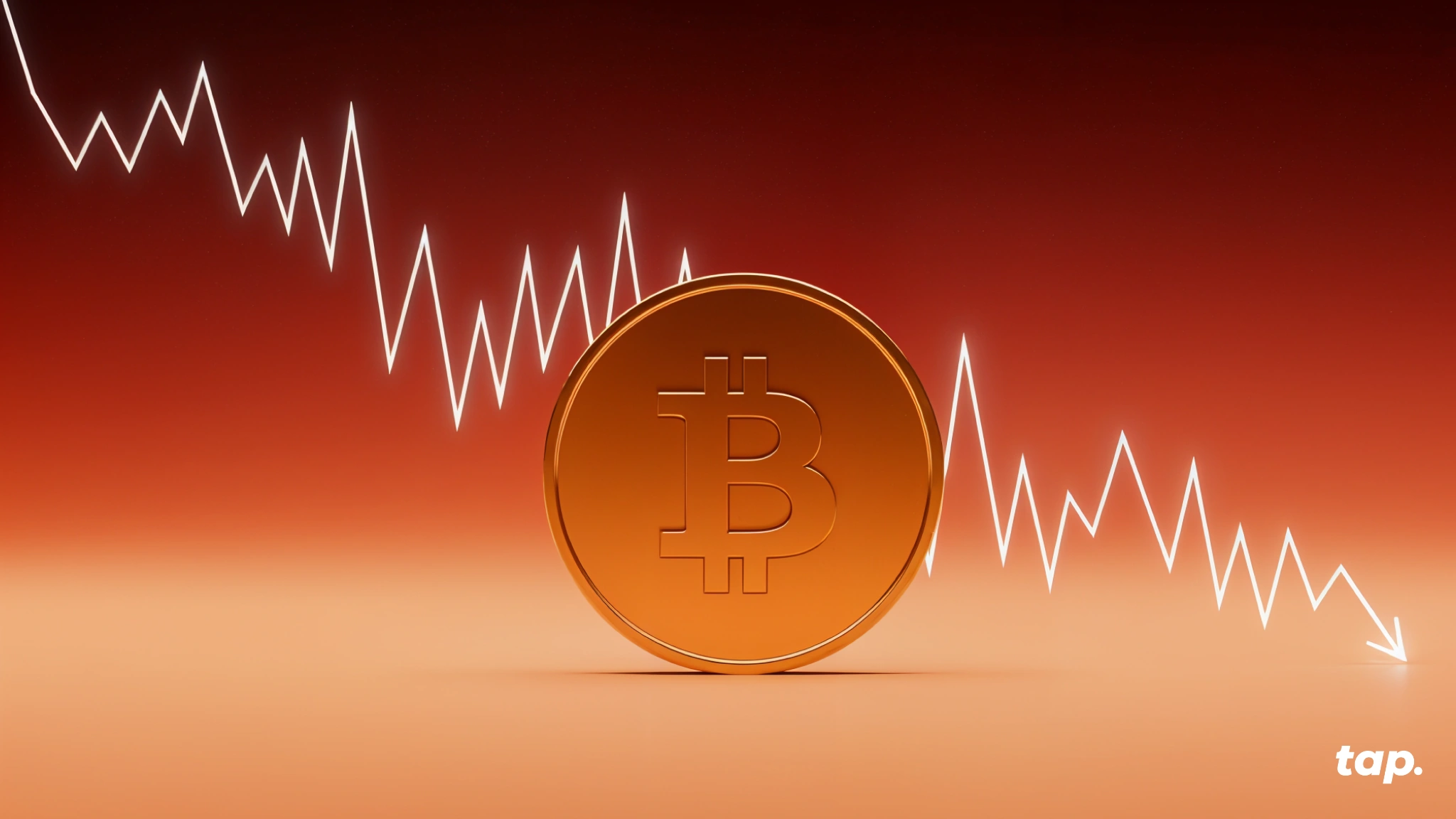
Bitcoin Crashes Below $82K in Brutal Sell-Off
After breaking through several support levels, Bitcoin is trading around $82,000, extending a punishing downtrend that has erased more than 30% of its value since October's peak at $126,000.
The cause? A perfect storm of selloffs in U.S. equity markets, which triggered a wave of risk aversion that swept through global markets. Meanwhile, the Federal Reserve's cautious stance on further rate cuts has injected fresh uncertainty into trading floors. Markets still anticipate a 0.25% cut, but with recession fears intensifying, traders are hitting the exits. Crypto found itself directly in the crosshairs of this flight to safety
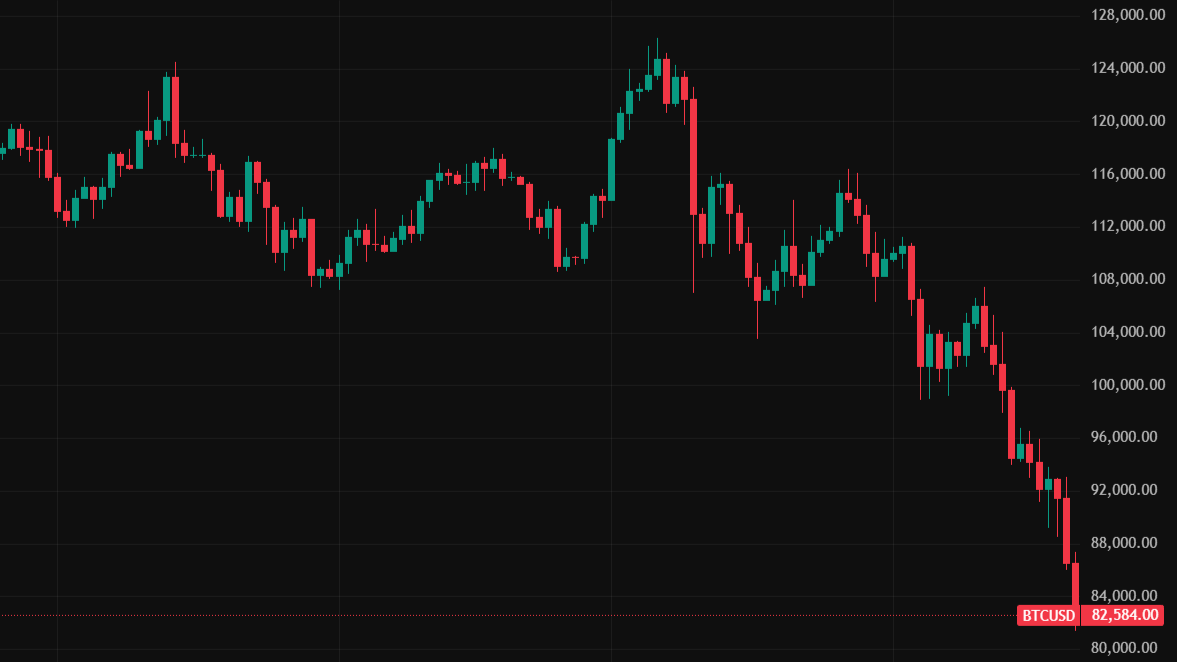
The damage extended well beyond Bitcoin. Estimates show around $2 billion in crypto positions liquidated, as forced selling and evaporating liquidity accelerated the downturn across digital assets. But here's a twist for you: Bitcoin is now entering territory that has historically preceded major recoveries. Let’s dive in.
Bitcoin Is Officially Oversold… And That Matters
The Relative Strength Index (RSI) has officially moved into oversold territory for the first time in nine months, signaling extreme selling pressure. The last time BTC hit oversold levels was in February, right before a notable rebound. Oversold signals don’t guarantee an immediate reversal, but they often mark the beginning of seller exhaustion.
In the previous oversold event, BTC dropped around an additional 10% before bouncing. If that were to happen again, BTC could briefly dip toward $77,000 before bulls regain momentum. If the current selling eases earlier, a shorter-term bounce could happen sooner.
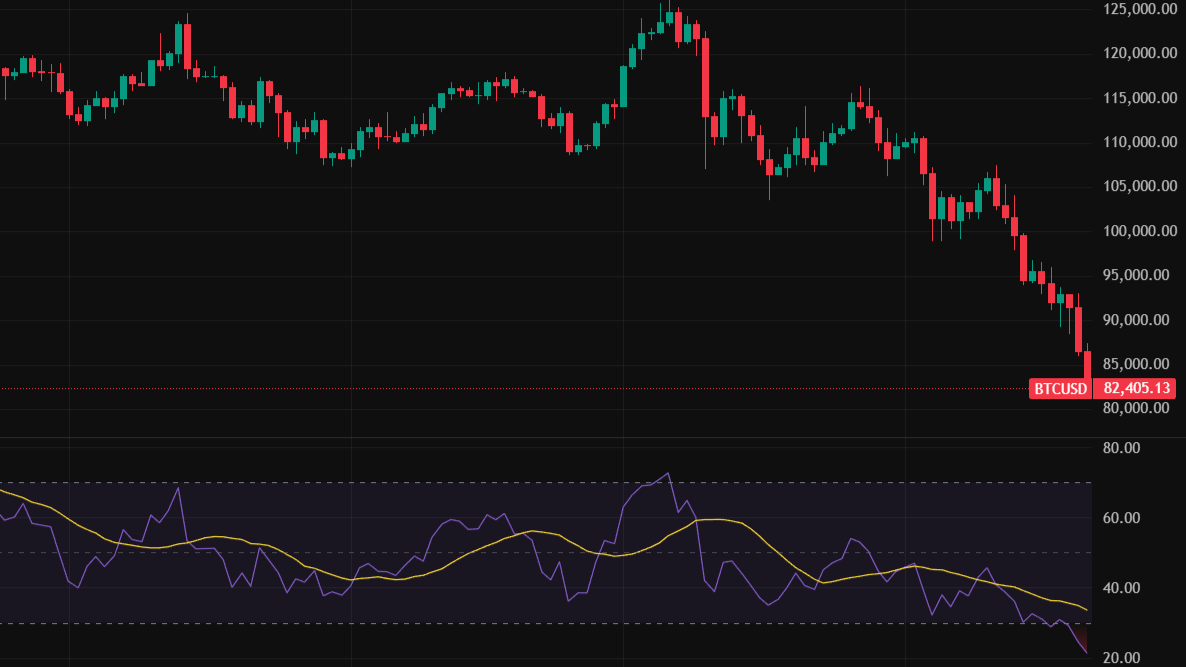
MVRV Points to Undervaluation
Another key indicator worth looking at is Bitcoin’s MVRV Ratio. This on-chain indicator reveals whether investors are collectively sitting on profits or losses. An MVRV Ratio above 1 means the average holder is in the green; below 1 signals most are underwater.
BTC’s MVRV now sits at 1.5, its lowest level in over two years. When MVRV enters a “opportunity zone”, it suggests two things:
- Many short-term holders are underwater
- Downside selling pressure is approaching exhaustion
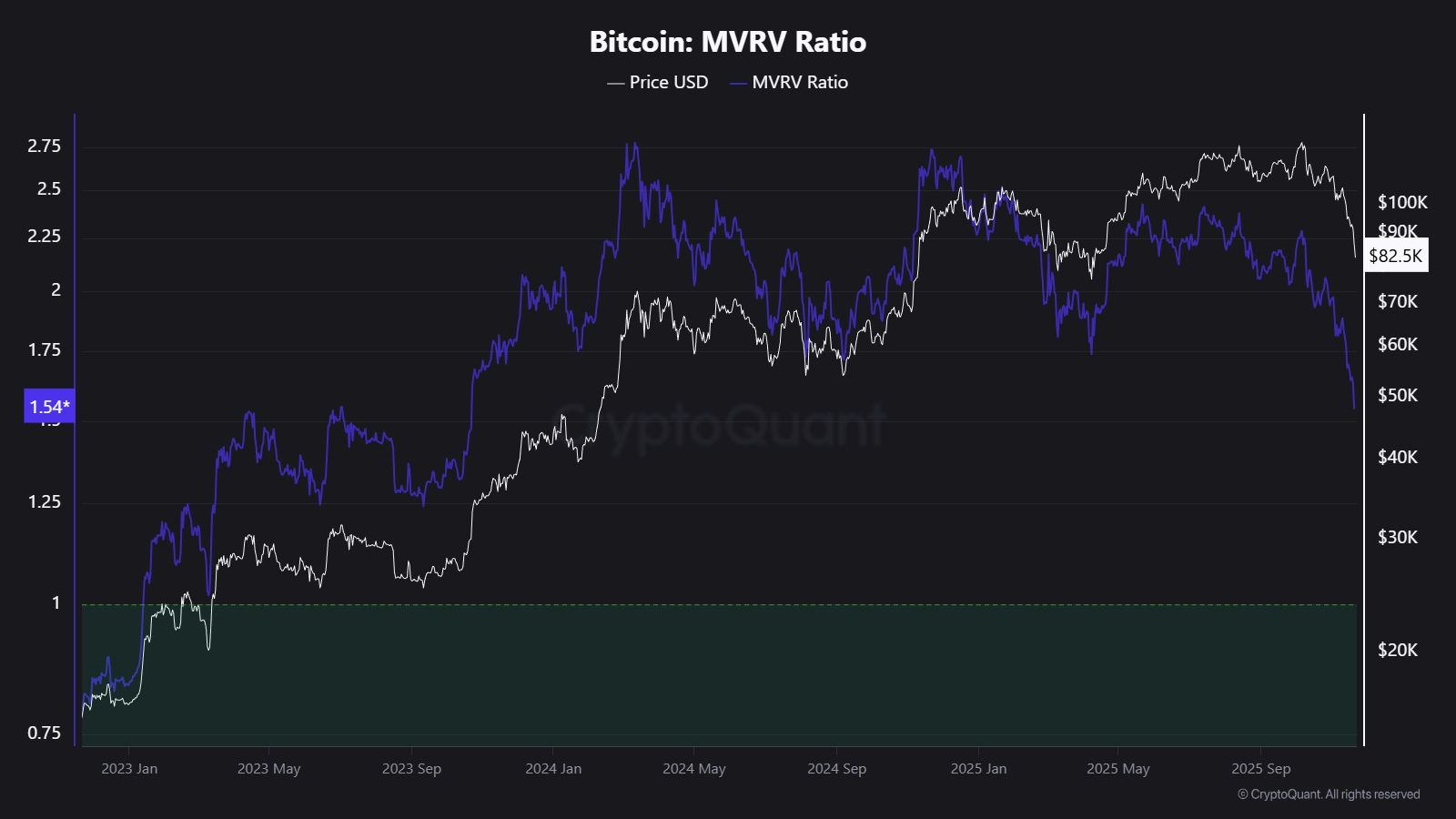
Key Levels to Watch
If bearish pressure continues, it’s possible BTC could revisit the $80,000 level, with a deeper support level around $77,000, matching the RSI’s recent historical pattern.
But there’s also a realistic bullish scenario: reclaiming $92,000 could turn the structure decisively bullish, opening the door to the $95,000 region and beyond.
What Can We Expect From BTC This November?
Beyond the indicators, there’s a seasonal angle worth emphasizing: Bitcoin has historically shown strong end-of-year recoveries and rallies. Even during weaker macro environments, Q4 has often delivered rebounds driven by renewed risk appetite and improved liquidity flows.
Combine that with oversold technicals, undervaluation signals, and easing macro uncertainty if the Fed does follow through on cuts, and the current levels could start looking less like panic territory and more like potential opportunity.
The Takeaway
Bitcoin's slide doesn’t appear to be driven by broken fundamentals; it's the result of macro turbulence, risk-off positioning, and temporary sentiment shifts. Short-term chop may persist, but on the flip side, key indicators are flashing oversold conditions which have historically marked turning points.
Corrections are part of Bitcoin's DNA. It has survived far steeper crashes and consistently emerged more resilient. Whether the bounce starts today or after one final shake-out, the pattern is familiar: selling exhaustion plants the seeds for the next rally. Patient holders have seen this pattern many times, and more often than not, their patience has been rewarded.
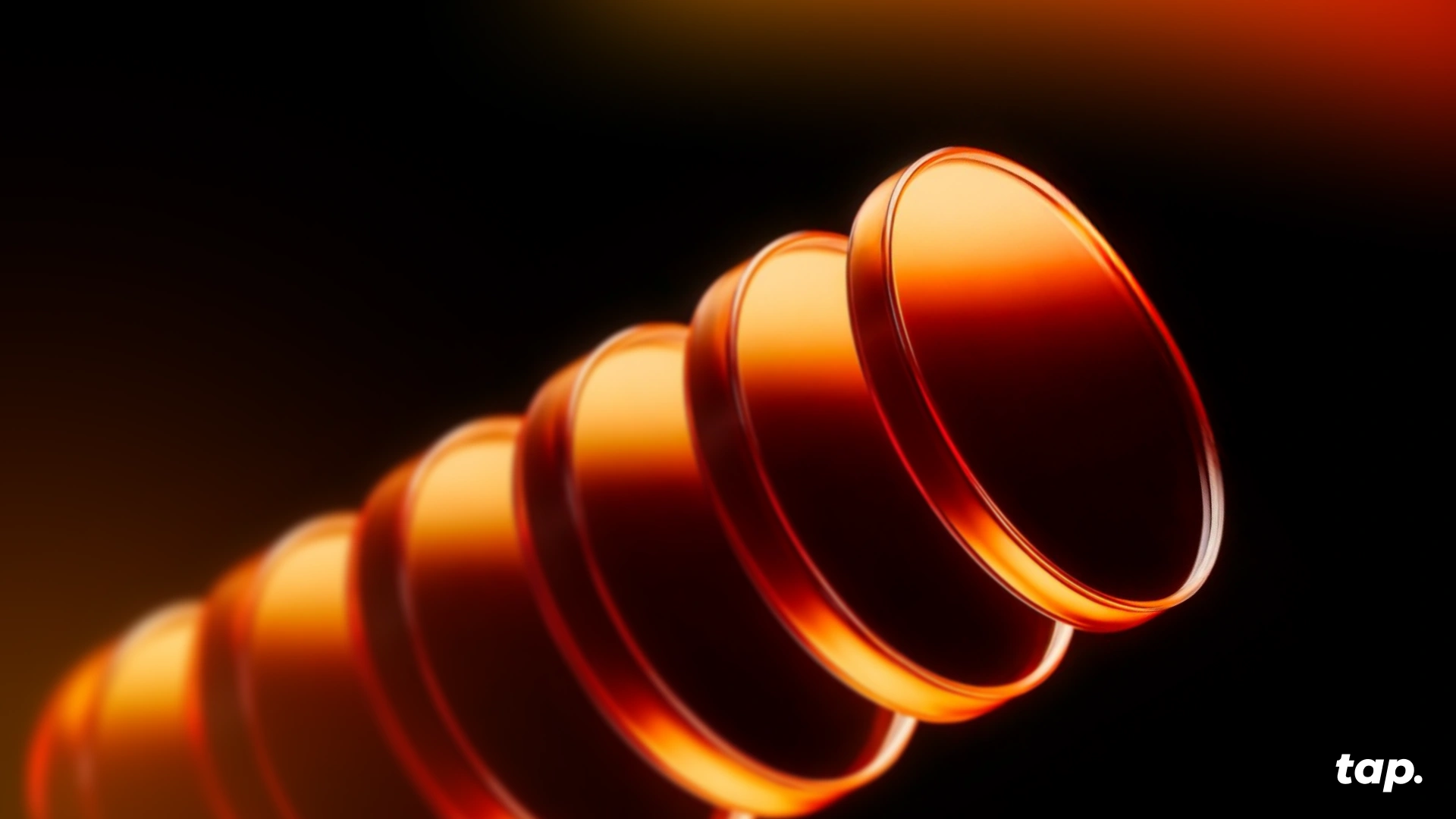
A Maturing Market in 2025
The world of cryptocurrencies in 2025 looks nothing like it did a year ago, and that's saying something in an industry that has seen it all. It has been a year of thrilling highs but also unexpected lows. Institutional money is flooding in through newly approved ETFs. Regulatory fog is dissipating in the United States, which gives both builders and investors clearer ground to stand on. Meanwhile, breakthroughs in DeFi, tokenization, and blockchain scalability are pushing the technology well beyond the realm of hype and speculative investments.
It’s clear the world of cryptocurrencies is evolving; the real question is which projects are spearheading that evolution. Whether you're a seasoned holder or just starting to pay attention, here are five digital assets that are worth your attention as the year draws to a close.
1. Bitcoin (BTC): The Golden Standard
You saw this one coming, didn’t you? To this very day, Bitcoin remains the anchor of the crypto ecosystem, influencing market sentiment, trading activity, and liquidity conditions across the whole industry. Following the April 2024 halving, BTC’s reduced issuance has contributed to renewed scarcity and a shift in mining economics.
Why You Should Watch BTC in 2025
- Institutional adoption: Bitcoin ETFs continue to attract interest, and they have managed to keep positive flows for most of the year. As time goes on, BTC integrates into portfolios and retirement products across traditional finance.
- Macro factors: With interest rates stabilizing, BTC remains a popular hedge against inflation, currency volatility, and macro uncertainty.
- Layer-2 scalability: Lightning Network improvements and new rollup-based solutions are enhancing transaction efficiency and expanding utility.
As of November 2025, BTC trades around $97,000 with a market capitalization near $2 trillion, having recently just reached an impressive new all-time high of $126,198. In spite of a recent downturn, it maintains its position as the dominant digital asset and a core indicator of broader market sentiment.

2. Ether (ETH): The Smart Contract Juggernaut
The Ethereum network continues to lead in smart contracts, decentralized applications, and tokenization initiatives. In that regard, nothing has changed. The network’s upgrades have reinforced its position as a scalable, energy-efficient computing platform.
Why You Should Watch ETH in 2025
- Post-merge efficiency: Proof-of-stake and extensive Layer-2 adoption significantly reduce fees and improve throughput.
- Enterprise adoption: Institutions and fintech companies are increasingly using Ethereum for settlement, Real-World Assets (RWAs), and programmable finance. Institutional ETH reserves have gone from less than a million ETH to more than 6 million during the course of this year.
- ETF exposure: ETH-based exchange-traded products have broadened access for retail and professional investors.
ETH trades near $3,200 after a historic rally that briefly took ETH to brand-new highs. It still ranks second in market value while maintaining the largest developer ecosystem in Web3.

3. XRP: The Cross-Border Connector
XRP continues to play a central role in modernizing international settlement, powered by Ripple’s growing partnerships with banks and payment platforms.
Why You Should Watch XRP in 2025
- Regulatory clarity: Positive rulings this year have strengthened confidence in XRP’s legal status across several jurisdictions.
- Bank integrations: Adoption in fast-growing regions supports higher transaction volume and utility.
- New payment corridors: Ripple’s liquidity network now enables transfers across a wide range of fiat and digital currencies.
XRP trades near $2.3 after almost reaching its all-time high earlier this year, and remains a top-tier cryptocurrency by market capitalization. It embodies the intersection of blockchain and traditional financial services now more than ever.

4. Solana (SOL): The High-Speed Contender
Solana has become known for speed and efficiency, enabling high-performance applications across gaming, DeFi, and NFTs. After earlier scalability issues, the network’s reliability has improved significantly.
Why You Should Watch SOL in 2025
- Institutional attention: The solana network is increasingly used for tokenized assets and real-time transactions.
- Ecosystem expansion: Developers continue launching new dApps, games, and decentralized exchanges capitalizing on fast settlement.
- Technical upgrades: Recent engineering improvements have boosted uptime and reduced network congestion.
Much like XRP, SOL came really close to reaching its all-time high but fell short. Currently, it trades near $142, solidifying itself as a major competitor in the Layer-1 landscape.
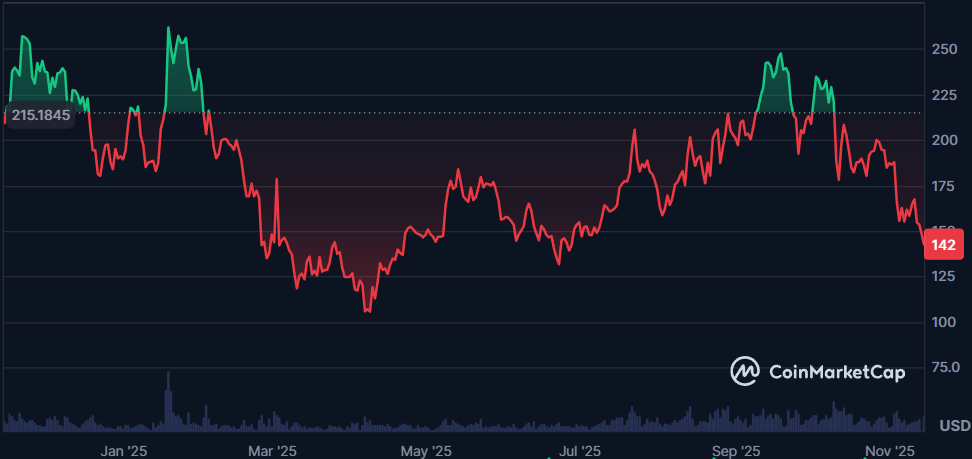
5. Chainlink (LINK): Powering the Data Economy
Chainlink remains the leading oracle solution, enabling secure data transfer between blockchains and the outside world. It’s essential for smart contracts, RWAs, and financial automation.
Why You Should Watch LINK in 2025
- RWA adoption: Banks and asset managers increasingly rely on Chainlink to support tokenized bonds, funds, and commodities.
- Cross-chain innovation: CCIP enables seamless interoperability across networks like Ethereum, Avalanche, Polygon, and Solana.
- Expanding integrations: Growth in enterprise adoption strengthens Chainlink’s role in decentralized finance and Web3 infrastructure.
LINK trades close to $14.2. Although still far from its all-time high, LINK has shown resilience during the current market downturn compared to other altcoins. Beyond price action, LINK underpins critical data processes across the digital asset ecosystem, which earns it the last sport on the list.

Why the End of 2025 Matters
So far, 2025 has been a pivotal year in the short history of crypto, and for better or worse, its last chapters seem to be following the same tone. Post-halving dynamics, ETF inflows, shifting liquidity conditions, and seasonal trading patterns all influence price movements and market behavior.
Past cycles have also set an exciting precedent. Historically, Q4 has shown higher volatility and stronger market participation compared to other quarters
Key Themes and Sectors to Follow
Beyond the charts, you can expect to hear more about these narratives, which tie directly to the cryptocurrencies highlighted above, making them important indicators of broader tech trends.
- Tokenization of real-world assets: Financial institutions increasingly use blockchain to issue and settle assets.
- AI-driven finance: Artificial intelligence is playing a larger role in trading tools, automation, and risk modeling.
- Layer-2 scaling: Growing demand for faster and cheaper transactions across multiple networks.
- Interoperability: Bridging networks to create unified digital ecosystems.
These narratives tie directly to the cryptocurrencies highlighted above, making them important indicators of broader technological and economic trends.
Conclusion
The final stretch of 2025 is undoubtedly shaping up to be a pivotal moment for the digital asset market. Bitcoin’s leadership, Ethereum’s scalable infrastructure, XRP’s global payment integrations, Solana’s high-speed capabilities, and Chainlink’s data-driven utility each contribute to a maturing ecosystem.
Whether the market consolidates or gears up for new highs, one thing is certain: the world of crypto will provide exciting developments to watch, as the hectic and unpredictable space we came to know and love steps further into a new age of widespread acceptance.

Something's shifting in crypto, and it's not just the charts. After weeks of sideways action and uncertainty, major developments out of the United States could be the catalyst that many were hoping for.
The timing couldn't be more interesting. Retail appetite is quietly building, whales are accumulating aggressively (especially in XRP), and macro conditions are starting to tilt back in crypto's favor. Individually, each of these catalysts matters. Combined, they set the stage for the kind of conditions that have historically preceded major shifts. Here's what you need to know, and why the next few weeks might be more important than most people realize.
1. U.S. Tariff Dividend
One of the biggest stories to watch is the “tariff dividend” President Donald Trump announced, a direct payment that could reach around $2,000 per person. The idea is that funds collected from higher import tariffs could be redistributed to citizens, effectively a form of economic stimulus. This could inject billions into consumer wallets, creating new liquidity across markets.
If history is any guide, such payouts can ripple into crypto. During the 2020 stimulus-era, Bitcoin saw a sharp uptick as retail investors channeled part of their checks into digital assets. The same pattern could repeat if a new wave of disposable income reaches American households, especially with crypto platforms now far more accessible than they were five years ago.
2. U.S. Government Shutdown Ending
Another factor lifting sentiment is the prospect of the U.S. government reopening. Political gridlock has weighed on markets, but signs of resolution have already sparked rallies across equities and digital assets alike. The relief comes as investors regain confidence that key economic functions will resume smoothly.

The last comparable event came in 2019, when a record-long U.S. shutdown ended after 35 days. Shortly afterward, Bitcoin began a sustained recovery, climbing from roughly $3,500 in late January 2019 to over $13,000 by mid-year. While correlation doesn’t imply causation, renewed fiscal clarity and market confidence often coincide with higher risk-appetite, the environment where crypto tends to thrive.
3. Pending ETF Approvals: Keep an Eye on XRP
Finally, the next big trigger could come from the regulatory side. Several new spot crypto ETF applications are nearing decision windows, with assets like XRP and Solana drawing heavy attention. The success of Bitcoin and Ethereum ETFs has already shown how much institutional demand can reshape liquidity and credibility in the space.
In particular, XRP could be one of the biggest winners. According to recent on-chain data, whales have accumulated more than $560 million worth of XRP in the past few weeks, a sign of growing confidence ahead of potential ETF approval. Broader adoption through regulated investment vehicles could finally unlock fresh capital inflows for alternative crypto assets beyond Bitcoin and Ethereum.
Bottom Line
Nothing is set in stone in crypto. But when liquidity, regulatory progress, and accumulation all start pointing in the same direction? That's when things get very interesting.
We're heading into the final stretch of 2025 with more aligned positive factors than we've seen in months. So, for anyone involved in crypto, whether you're trading daily or holding, now's the time to stay plugged in.
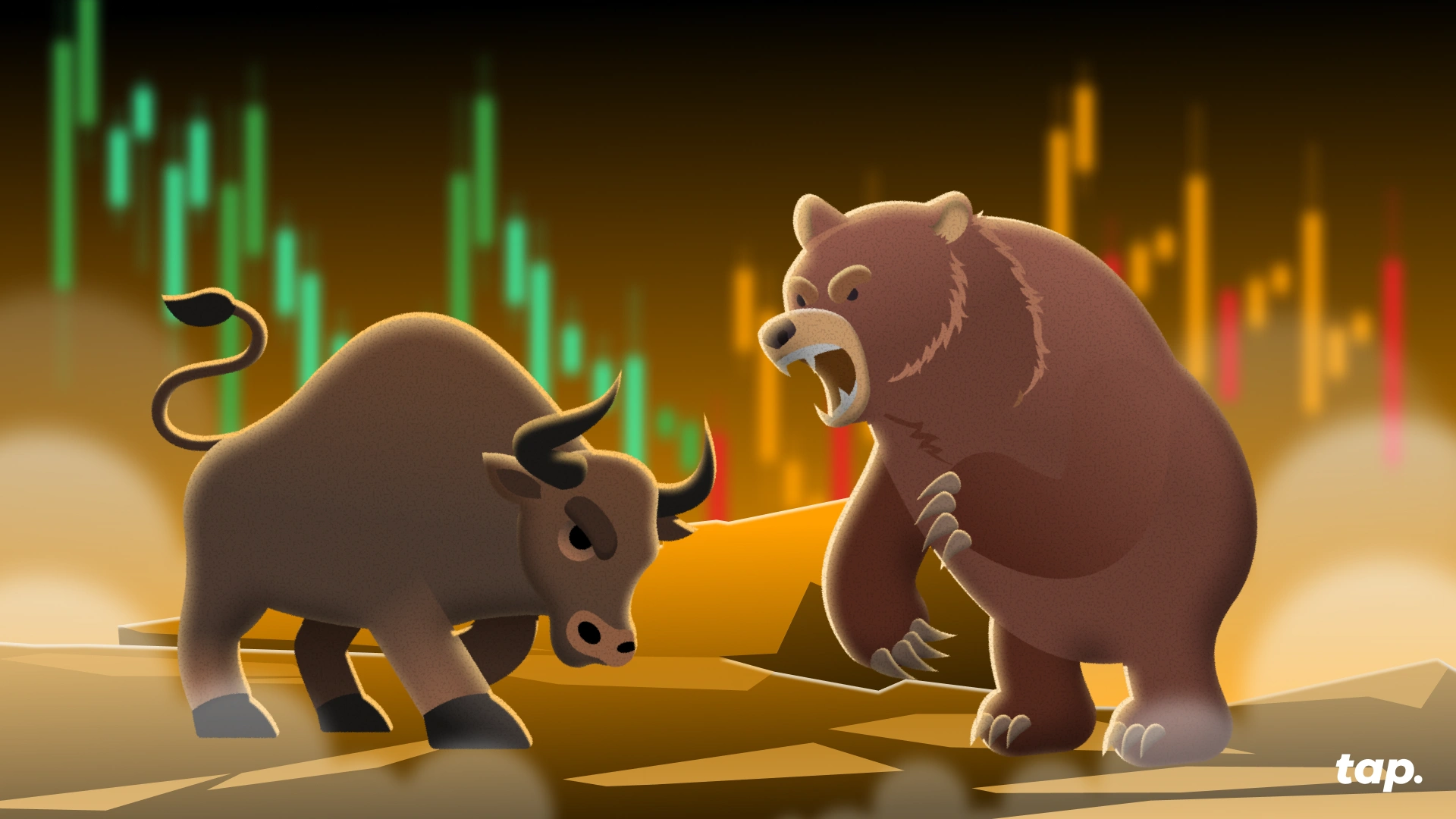
After a volatile October that saw one of the sharpest two-day liquidations of the year, the crypto market is trying to regain its footing, but conviction remains divided. Bitcoin has stabilized near key support levels, while altcoins fight against selling pressure. With macro, policy, and on-chain factors all in play, the debate between the bull and bear camps is as alive as ever. Let’s unpack the forces shaping both sides of the ledger.
The Bear Case
When Good News Don’t Move Prices
Despite encouraging ETF data and easing rate expectations, crypto failed to rally in late October, a classic warning sign of risk fatigue. According to Farside Investors, U.S. spot Bitcoin ETFs saw outflows of $470 million, $488 million, and $191 million between October 29 and 31, signaling that short-term traders were taking profits or stepping aside after “Uptober” fizzled out.
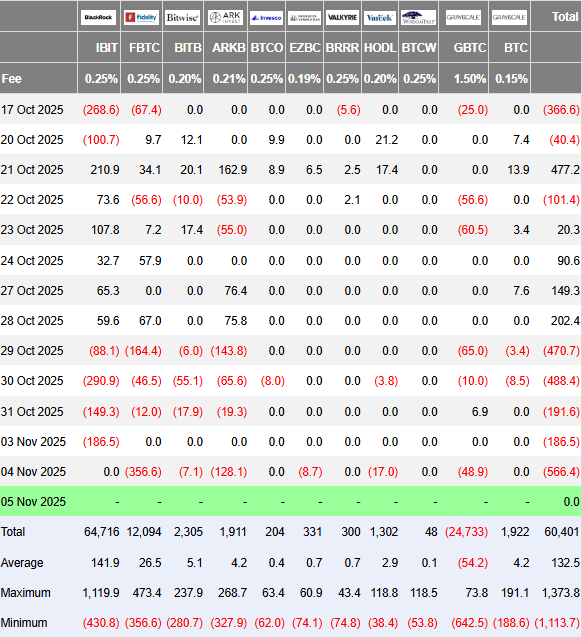
The AI Narrative
Macro sentiment still casts a long shadow. The tech-heavy equity rally, driven by AI infrastructure and chip stocks, has stirred debate about overvaluation. Nvidia’s brief breach of a $5 trillion valuation in late October triggered flashbacks of the dot-com era. If AI equities begin to deflate, crypto could feel the wealth effect unwind, as liquidity shifts from speculative assets to safer havens.
The 10/10 Crash Aftershock
The October 10 downturn marked one of the largest single-day liquidations in recent memory. Analysts note that this event left traders hunting for “dead entities” and potential hidden losses, injecting caution across the market. Even with recovery underway, scars from that drop remain fresh.
Post-Halving Cycle Timing
Bitcoin’s halving on April 20, 2024 (block 840,000) reset expectations, but it also reignited the age-old question: where are we in the cycle? Historically, the strongest rallies have occurred before or shortly after the halving, not a full year later. Some analysts now argue that the current consolidation could represent a late-cycle phase rather than the start of a new one.
Dormant Wallets Awakening
On-chain data from CryptoQuant shows that long-term holders have increased net distribution since mid-October, with tens of thousands of BTC re-entering circulation. Several Satoshi-era wallets have also moved funds, not necessarily bearish in isolation, but enough to add pressure and short-term supply.

The Bull Case
No Signs of Euphoria
Market positioning remains far from overheated. The Crypto Fear & Greed Index currently sits in the 20s, and has been recently hovering between “Fear” and “Neutral.” That’s a far cry from the exuberant 80s to 90s readings that often precede blow-off tops. In practical terms, this suggests there’s still room for sentiment to improve before the market becomes dangerously crowded.
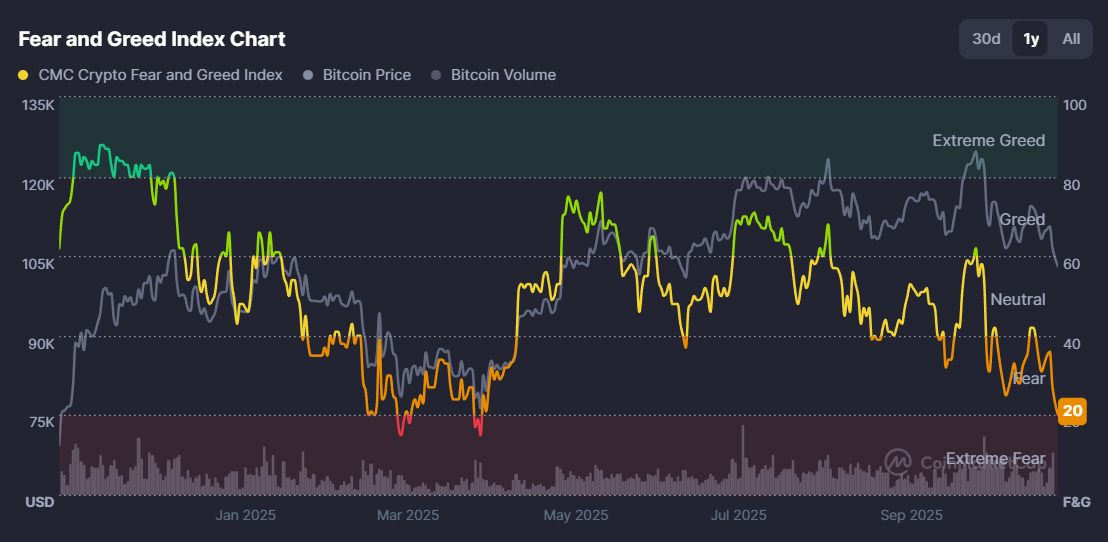
Liquidity Is Turning
Central banks are easing. The European Central Bank has already paused, the Bank of England has begun cutting, and the U.S. Federal Reserve is expected to follow suit with at least one more rate cut by year-end. According to the CME FedWatch Tool, the odds of a 0.25% cut currently stand above 70%. Historically, easing cycles have correlated strongly with renewed crypto uptrends, as lower yields push investors back into risk assets.
Institutional Adoption Keeps Compounding
Spot ETFs remain the biggest driver of credibility and inflows this year. Despite short-term outflows, global crypto investment products reached $921 million as recently as last week. That steady institutional presence gives crypto markets deeper liquidity and a stronger foundation than in previous cycles, where retail speculation dominated.
The Seasonal Edge
Seasonality adds another bullish data point. Since 2013, Q4 has consistently been Bitcoin’s strongest quarter on average. With November historically delivering above-average performance, many traders see the current consolidation not as a ceiling, but as a potential setup, particularly if macro data softens and ETF inflows resume.
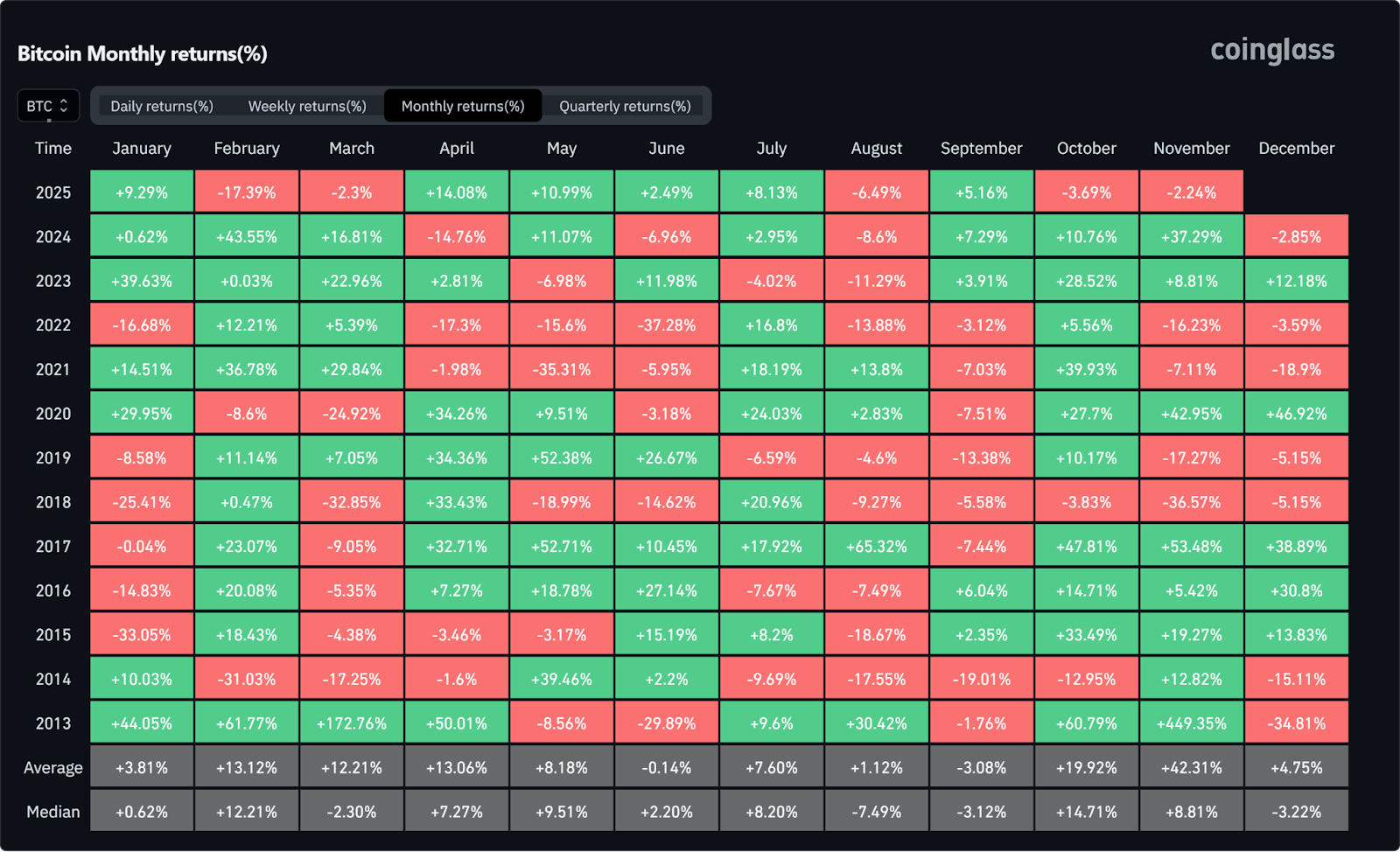
Improving Global Sentiment
Finally, the U.S.–China trade thaw is a quiet but important catalyst. China has agreed to pause 24% tariffs on U.S. goods, marking the most significant de-escalation yet. For global risk assets, that’s a relief valve, potentially restoring confidence in emerging markets and crypto alike.
Final Verdict
Crypto’s tug-of-war between optimism and caution is far from over. The bull camp points to liquidity, policy progress, and institutional growth as evidence of a maturing ecosystem. The bears, on the other hand, warn that cycle timing, macro fragility, and old-wallet selling could cap any short-term rally.
Currently, the most realistic view lies somewhere in between these two extremes. After October's flash crash sent shockwaves through the market, a period of recalibration has taken hold. Whenever the next significant high arrives, the current environment may be best described not as peak fear or euphoria, but as consolidation.

As digital assets become a core part of personal wealth, one uncomfortable question lingers: what will happen to your crypto when you’re gone? Unlike traditional assets that can be managed through banks or brokers, cryptocurrencies are bound entirely to whoever holds their private keys. Lose the keys, and the funds are gone. Permanently.
Crypto Vanishes All the Time
Each year, millions of dollars in Bitcoin, Ether, and other tokens vanish into the digital void when holders pass away without sharing access. It is estimated that around 1.5 million BTC (roughly 7.5% of total supply) may already be lost forever. With digital wealth now part of countless estates, preparing for the inevitable is no longer optional; it’s the responsible thing to do.
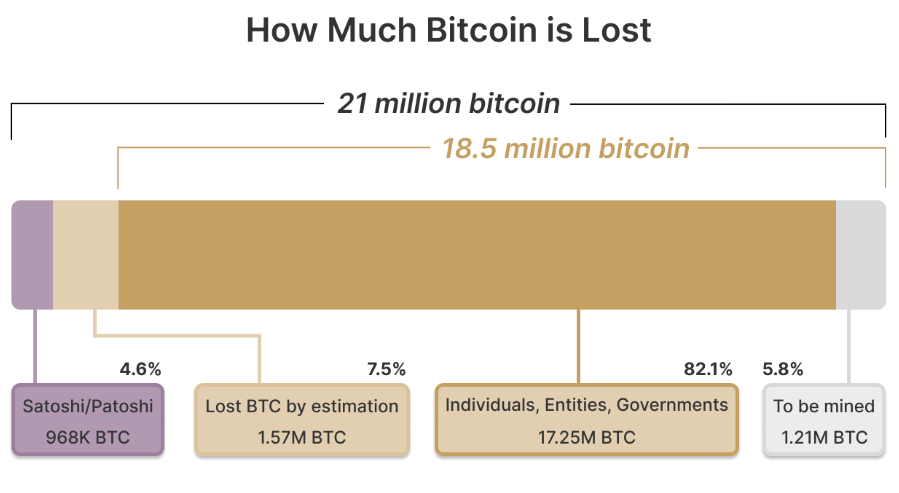
Why Planning for Crypto Inheritance Matters
In traditional finance, wealth transfer is handled through wills, trusts, and custodians. But crypto flips that model: you are the bank. Your heirs can’t simply request a password reset or call customer service. Without private keys, wallets, or access instructions, those assets are unrecoverable for all effects and purposes.
A crypto inheritance plan ensures that your digital assets, from Bitcoin and altcoins to NFTs and DeFi holdings, remain both secure and accessible to the people you choose. It bridges two crucial needs: protecting your funds today and ensuring your legacy tomorrow.
Beyond personal security, inheritance planning also reduces emotional and financial stress for your loved ones. By documenting how and where assets can be accessed, you prevent confusion and potential legal disputes.
Building the Foundation of a Crypto Inheritance Plan
Start with Legal Clarity
Consult an attorney familiar with digital assets. A properly structured will or trust should identify your crypto holdings, list beneficiaries, and outline how they can access those funds. Many jurisdictions still lack explicit laws for digital assets, so expert guidance helps ensure compliance and enforceability.
Secure Your Keys… But Don’t Overshare
The biggest challenge in crypto inheritance is private key management. If you die with your keys, your crypto dies with you. However, leaving keys in plain text within a will or document is just as risky. Instead, consider approaches like:
- Multisignature wallets, which require multiple approvals to move funds.
- Shamir’s Secret Sharing, which means splitting your seed phrase into parts distributed among trusted people.
- Encrypted backups or sealed letters stored in secure, offline locations.
Document recovery procedures in plain language so your heirs can follow them even without technical knowledge.
Choose the Right Executor
A traditional executor may not understand how to navigate crypto. You can appoint a tech-literate executor or designate a digital asset custodian to handle that portion of your estate. This ensures smooth execution and reduces the risk of errors or loss.
In a market driven by innovation and constant change, a well-structured inheritance plan offers something rare in crypto, certainty.
New Tools for a Digital Age
The rise of blockchain-based “death protocols” and smart contract automation adds a new layer of possibilities. Some platforms allow transfers to trigger automatically after certain conditions are met (for example, a verifiable death certificate or extended inactivity).
Ethereum and similar chains already support programmable inheritance systems, but these should complement, not replace, legal documents. Technology can help enforce your intentions, but law remains the foundation of inheritance.
Some investors even use “dead man’s switches”, automated systems that transfer funds if the owner doesn’t log in for a set period. While clever, it might be best to pair them with legal documents to prevent accidental activations.
Protecting Privacy While Planning Ahead
While planning for the future, it’s crucial to maintain security in the present. Avoid including wallet addresses, private keys, or passwords in public wills, which become part of the legal record. Instead, store such details in encrypted files or sealed envelopes accessible only to specific individuals.
Tools like decentralized identifiers (DIDs) and verifiable credentials can also help manage long-term identity and access rights. These systems allow you to define who can access what, and when, without intermediaries.
Custodial vs. Non-Custodial: Finding the Balance
When structuring inheritance, knowing whether your assets are held in custodial or non-custodial wallets makes all the difference.
Custodial services (like major exchanges) manage private keys on your behalf, which simplifies recovery if your heirs can provide proper documentation. However, it introduces third-party risk. Accounts can be frozen, hacked, or shut down.
Non-custodial wallets, on the other hand, offer maximum control and privacy but demand greater responsibility. If your heirs lose the seed phrase, there’s no backup plan. There’s also the possibility of taking a hybrid approach: keeping long-term holdings in non-custodial storage for security, while using reputable custodians for smaller, more accessible amounts.
Keep It Up to Date
A crypto inheritance plan is not a “set it and forget it” document. Prices change, portfolios evolve, and wallet technologies become obsolete very often. It may be wise to revisit your plan regularly, especially after major life events such as marriage, divorce, or the birth of a child.
It’s also worth keeping track of regulatory updates in your jurisdiction. Laws surrounding digital assets and inheritance are rapidly evolving, and what’s compliant today may not be tomorrow.
Common Inheritance Pitfalls
Even the best intentions can go wrong. Here are the most frequent mistakes to avoid:
- Including seed phrases directly in your will. As we mentioned before, this makes them public and vulnerable.
- Neglecting to educate heirs. Without guidance, even secure plans can fail.
- Relying solely on exchanges. Centralized platforms can fail or freeze funds.
Planning isn’t just about distributing wealth; it’s about ensuring continuity. A clear inheritance strategy preserves your crypto’s value and prevents it from becoming part of the estimated $100 billion in lost digital assets worldwide.
Protecting More Than Just Coins
Preparing a crypto inheritance plan isn’t merely about money; it’s about legacy. For all the talk about decentralization and autonomy, responsibility and forward-thinking remain at the heart of crypto ownership. By taking the time to plan ahead, you safeguard not only your wealth but also your family’s peace of mind.
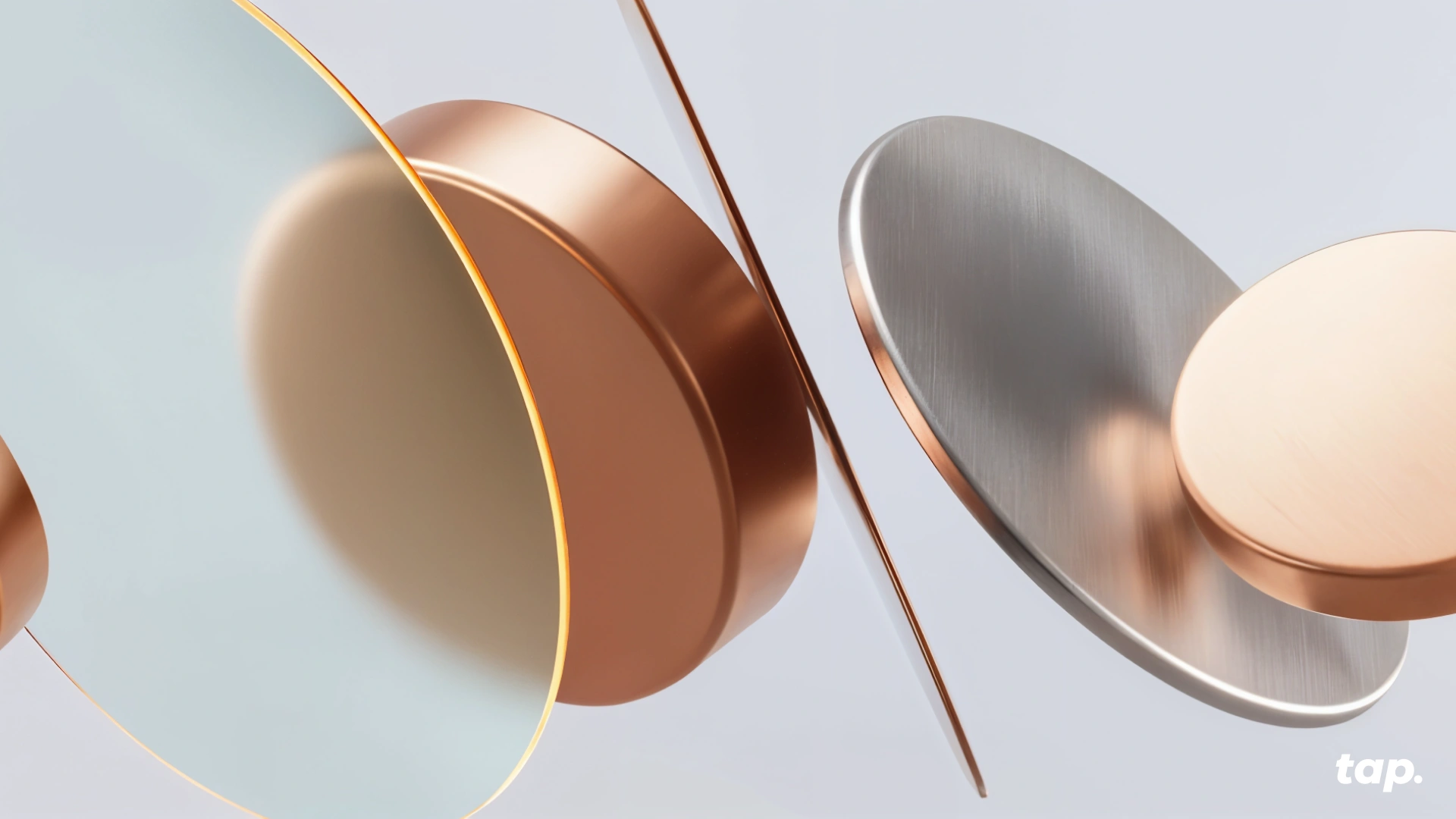
As we move into November 2025, the crypto-market is gearing up for one of its most intriguing phases yet. From spot-ETF momentum to narrative shifts, network upgrades and real-world asset tokenization, multiple catalysts are aligning. Here are six key developments to watch.
1. Seasonality & Historical Momentum Could Kick In
While "Uptober" fell short of expectations, November could tell a different story. Historically, it's been one of the strongest months for digital assets, with Bitcoin in particular averaging +42.31% gains in recent years.

When combined with the renewed ETF narrative, increased whale accumulation, and a stronger appetite for risk assets, market momentum appears to be building. Participants are closely monitoring how these dynamics could influence sentiment, especially as trading volumes and key technical levels come into play. If Bitcoin maintains stability around the $100K zone and Ethereum shows signs of renewed strength, November could become a more active month for crypto markets compared to October.
2. Ether’s Next Move Could Set the Tone for Altcoins
The final weeks of 2025 may prove pivotal for Ethereum (ETH). Although retail accumulation has paused somewhat, wallet-level data shows large holders (1,000 to 100,000 ETH wallets) added roughly 1.6 million ETH in October (around $6 billion), it’s a sign that whales and larger holders are staying active as the year winds down.
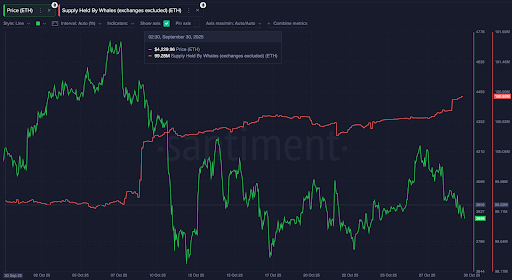
If ETH begins to break out or even stabilize around current levels, it could unlock the broader altcoin market, which has been lagging for months. The playbook that many are hoping for is the following one: ETH strength leads to improved risk appetite, which in turn sparks an altcoin rotation as investors seek higher risk exposure.
Ethereum remains the accepted benchmark for gauging sentiment across the non-Bitcoin segment of the market, and its performance frequently acts as a catalyst for capital flows into smaller assets. Keeping an eye on its fundamentals (from staking yield to liquidity shifts on major exchanges) will be important. In many ways, ETH could potentially become the gatekeeper to the next phase of the market’s recovery and the tone-setter for the coming months.
3. ETF Comeback After Delays
The recent U.S. government shutdown briefly froze several crypto-spot ETF filings, leaving the “ETF narrative” in suspense. But now the pause is over for Bitwise’s Spot Solana ETF. It has finally launched with strong early inflows, and the broader momentum is returning.
With this foundation, November could reignite the ETF trade in earnest, we may finally see filings for Ethereum staking products, new spot-Bitcoin funds and renewed institutional interest. If filings begin to stack up and regulatory engagement deepens, this could mark the next major inflection for how crypto is accessed in traditional portfolios.
4. Altcoins at an Inflection Point
The broader altcoin sector enters November under pressure as the Altcoin Season Index sits near 29, signaling a reset after October’s downturn. But inflection points often follow pressure. If ETH sets the tone (as many are hoping for), mid-cap and high-beta altcoins (such as SOL, AVAX, NEAR) could begin to capture rotation flows.

Traders might want to watch for flow changes such as increased volumes, wallet relocations and new project launches. While caution is still prevailing, this may be the window where sentiment begins to swing back into “altcoin season”.
5. Major Network Upgrades
Technical infrastructure is not just background noise; it often creates catalyst-events. For example, Ethereum’s upcoming Fusaka Upgrade (scheduled for early December) is designed to increase layer-2 data capacity and reduce transaction costs.
Meanwhile, various Layer-2 ecosystems are preparing upgrades and cross-chain activations. One such upgrade, Shibarium Upgrade’s security overhaul on the Shiba Inu network. These events may ignite renewed network activity, developer interest and capital flows into ecosystems ready to scale.
6. Real-World Asset (RWA) Tokenization Accelerates
The tokenization of real-world assets (RWAs), such as real estate, bonds, equities, is moving from niche to mainstream. For instance, according to Standard Chartered, this market is projected to grow to around $2 trillion by 2028. Institutional interest is burgeoning, and regulatory frameworks are emerging.
As November unfolds, we may see announcements of large tokenization initiatives or new platforms bridging DeFi and traditional finance. For crypto holders and ecosystem observers, this means the familiar “crypto only” narrative is expanding into real-asset integration, a meaningful broadening of the opportunity set.
The Verdict
November 2025 is shaping up to be more than just another month. Spot-ETFs potential, ETH’s path, altcoin rotation, seasonal tailwinds, infrastructure upgrades and RWA tokenization all sit in motion. Each one individually is significant; together they create a multi-vector setup.
For those in the crypto space, whether you're holding long-term, actively trading, or building the next wave of infrastructure, November is likely to be eventful. This isn't a month to coast on autopilot. Track where capital is flowing. Pay attention to which narratives are gaining momentum and which are fading. The players are moving, and the pieces are falling into place.
Kickstart your financial journey
Ready to take the first step? Join forward-thinking traders and savvy money users. Unlock new possibilities and start your path to success today.
Get started